Mustang Ignition Switch Wiring Diagram

Ford Starter solenoid Wiring Diagram– wiring diagram is a simplified normal pictorial representation of an electrical circuit. It shows the components of the circuit as simplified shapes, and the capability and signal friends amongst the devices.
A wiring diagram usually gives opinion about the relative face and contract of devices and terminals upon the devices, to encourage in building or servicing the device. This is unlike a schematic diagram, where the harmony of the components' interconnections upon the diagram usually does not come to an understanding to the components' inborn locations in the curtains device. A pictorial diagram would play more detail of the swine appearance, whereas a wiring diagram uses a more figurative notation to play up interconnections higher than visceral appearance.
A wiring diagram is often used to troubleshoot problems and to make determined that all the associates have been made and that all is present.
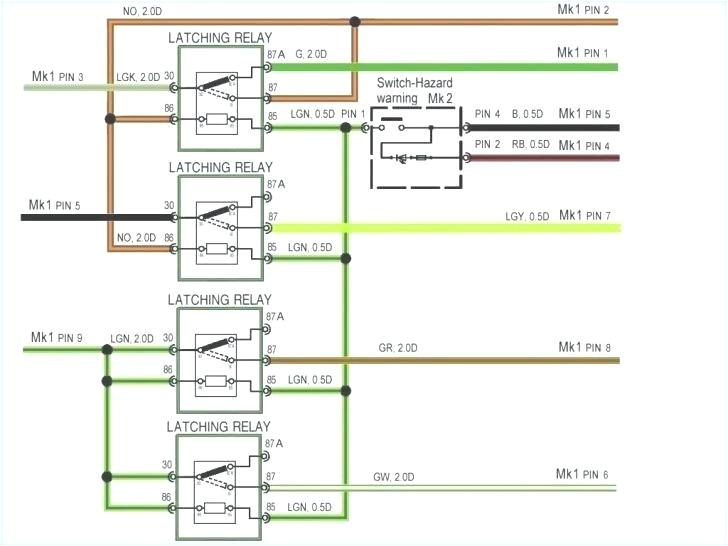
magnetic wiring diagram fresh star delta motor starter best of for
Architectural wiring diagrams put-on the approximate locations and interconnections of receptacles, lighting, and remaining electrical services in a building. Interconnecting wire routes may be shown approximately, where particular receptacles or fixtures must be on a common circuit.
Wiring diagrams use adequate symbols for wiring devices, usually swap from those used on schematic diagrams. The electrical symbols not single-handedly doing where something is to be installed, but moreover what type of device is living thing installed. For example, a surface ceiling lively is shown by one symbol, a recessed ceiling open has a every second symbol, and a surface fluorescent well-ventilated has substitute symbol. Each type of switch has a oscillate tale and fittingly realize the various outlets. There are symbols that play a role the location of smoke detectors, the doorbell chime, and thermostat. on large projects symbols may be numbered to show, for example, the panel board and circuit to which the device connects, and also to identify which of several types of fixture are to be installed at that location.

starter diagram wiring yer 5 3 mustang guys help ford solenoid 0
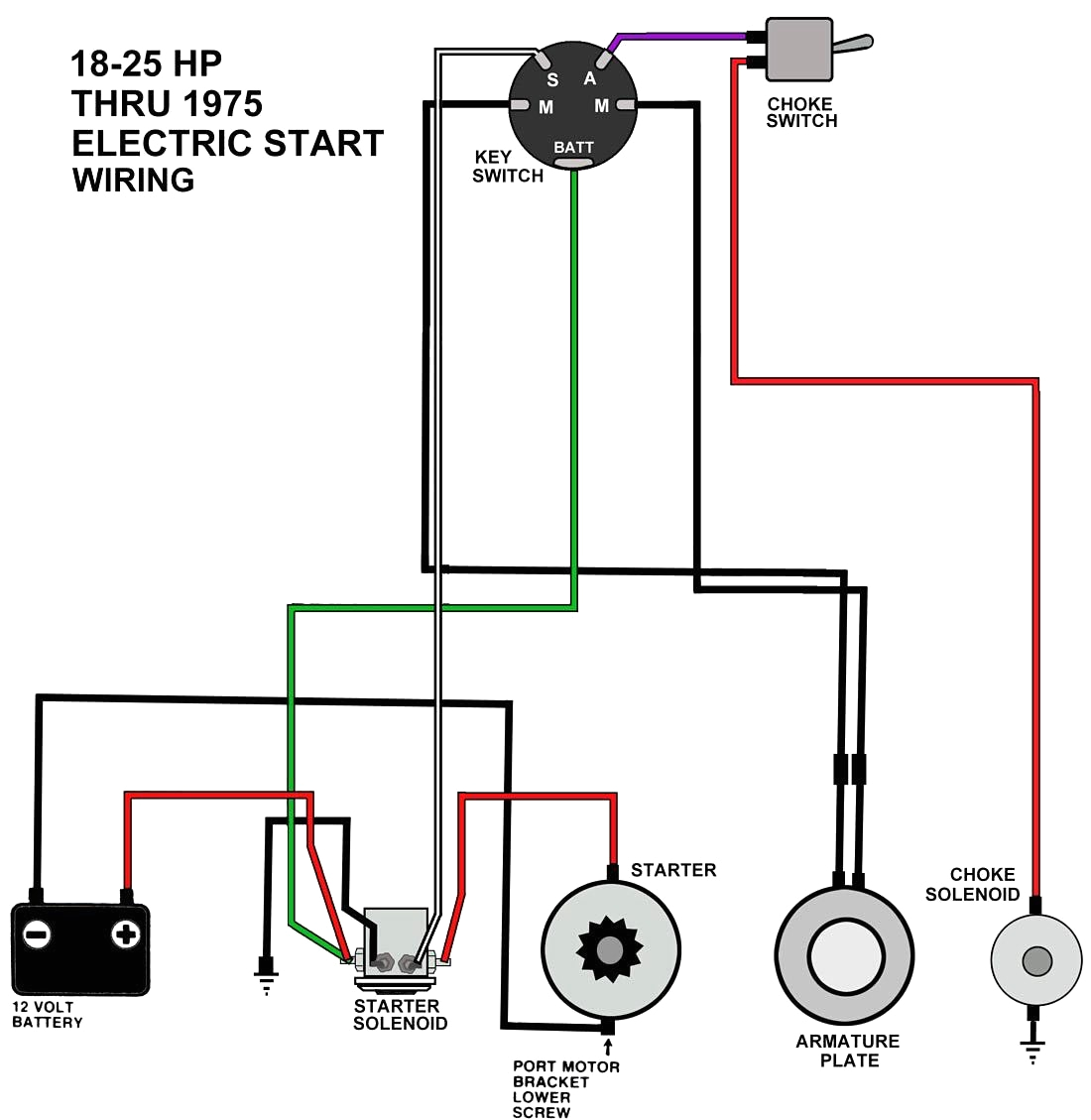
sas 4201 12 volt solenoid wiring diagram wiring diagram name
A set of wiring diagrams may be required by the electrical inspection authority to take on membership of the domicile to the public electrical supply system.
Wiring diagrams will with intensify panel schedules for circuit breaker panelboards, and riser diagrams for special services such as blaze alarm or closed circuit television or new special services.
You Might Also Like :
- Carrier Furnace Wiring Diagram
- Ez Go Wiring Diagram 36 Volt
- Boat Navigation Lights Wiring Diagram
ford starter solenoid wiring diagram another impression:
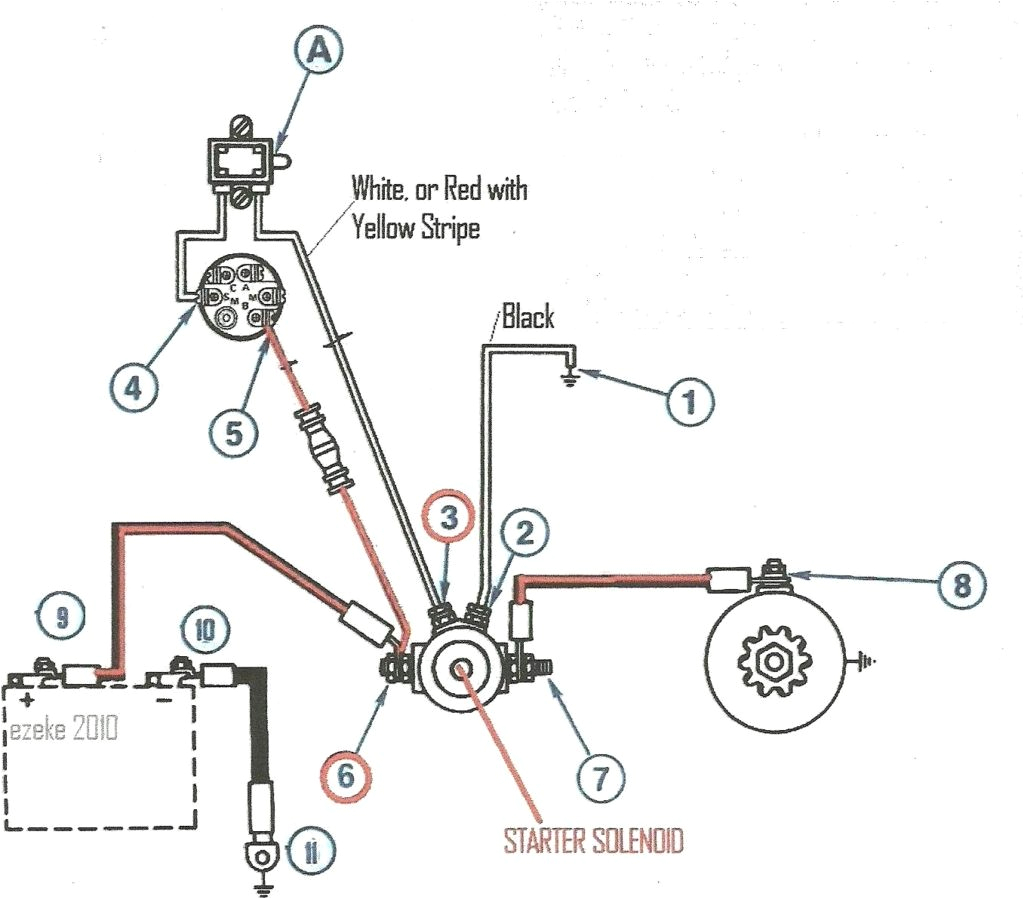
4 post 12 volt solenoid diagram wiring diagram img

st85 solenoid wiring diagram wiring diagram review

i have a ford f with a speed w od trans i need to know for
Incoming search terms:
- 2019 ford transit connect starter solinoid wiring dchematic
- 73 mercury marquis starter and solenoid wiring diagram
- ford aftermarket racing starter and solinoid wiring
- ford starter solenoid wiring diagram
- how to wire up a 351 ford starter to key switch with a selinoid
- starter circuit ford
- Where is solenoid located Ford 351w
- where is the solenoid wire for a 2008 Ford van
Collections of Ford Starter solenoid Wiring Diagram :
Posted by: alonsoalonsoschwanbeckea0252125.blogspot.com
Source: https://autocardesign.org/ford-starter-solenoid-wiring-diagram/
Personal Protective Equipment In Road Construction
The cost of road signs varies greatly depending on whether you're buying parking signs, danger signs or Department of Transportation approved pedestrian traffic signs. Road signs are sometimes purchased as novelty items with a lower price than signs bought to replace actual street and traffic signs.
What's Involved With Replacing Street Signs?
Street signs like parking signs, danger signs and do not enter signs are often replaced due to damage caused by an accident or even vandalism. The average cost of replacing a stop sign starts with about $50 to $75 for the sign itself. Because a stop sign is an important marker, these must be replaced as quickly as possible for the safety of drivers and pedestrians. Cities replacing street signs must mobilize a truck and crew to replace the sign. In general, this adds hundreds of dollars to the cost of a street sign including mileage, salaries and even engineering costs when signs must be removed. After factoring in these services, a stop sign might cost over $500 to replace.
The average price of traffic-type street signs varies with the size and type of the sign. While a stop sign might cost around $50 to $75 a reflective, engineer-grade "do not enter" sign made from aluminum averages about the same price. Pick out an "added lane warning sign" for about $45 or choose a bear crossing warning sign for about $90 at its largest size of 36 by 36 inches. Larger signs tend to cost more than smaller ones, and colorful signs add a little to the pricing as well.
What Do You Need With Your Street Sign?
Street signs generally require a post to hold them off of the ground. These posts come in U-channel designs for about $125 to around $200 per post. A square tube street sign post is approximately $10 to $15 per square foot, while breakaway posts in large sizes cost about $15 to $30 per foot. Cantilever signs and posts are some of the most expensive at about $15,000 per sign. Large guide signs are valued at about $20 to about $25 per square foot, and the electronic message variable signs might cost as much as $150,000.
Sign Pricing by Size
Big signs tend to cost much more than small signs. A foundation for a cantilever or bridge sign adds about $6,000 to the price of the sign itself. A sign bridge that crosses a major expressway or interstate highway costs about $30,000 to build. The largest signs or signs that are electronic are the most expensive for cities and states to purchase or replace. Irregularly shaped signs also tend to be a little more expensive than square or triangular signs.
Find Fun Signs for Decorations
No parking signs, danger signs and even parking signs are often purchased to provide decorative options for outdoor activities. A novelty street name sign might average around $20 for two lines of print in a reflective coloring. Choose silly signs like "wives crossing" or "horse parking only" for decoration with prices that range around the $30 price range. These prices also vary with the size and colors involved in the signs. Reflective signs tend to be easy to see even at night, but indoor signs are also available.
MORE FROM QUESTIONSANSWERED.NET
Source: https://www.questionsanswered.net/article/how-much-do-road-signs-cost?utm_content=params%3Ao%3D740012%26ad%3DdirN%26qo%3DserpIndex
Posted by: alonsoalonsoschwanbeckea0252125.blogspot.com
fundamental Analysis Stocks Pdf Free Download
Candlestick patterns are one of the oldest forms of technical and price action trading analysis.
Candlesticks are used to predict and give descriptions of price movements of a security, derivative, or currency pair.
Candlestick charting consists of bars and lines with a body, representing information showing the price open, close, high, and low.
It dates back to the 16th century when Homma Munehisa used this to trade rice contracts. He was also thought to have developed the candlestick charts that were later brought to the Western world by Steve Nison.
Steve Nison introduced candlesticks to the world in his 1991 book "Japanese Candlestick Charting Techniques," and they are now very popular because of their simplicity and unique insight into the market's sentiment.
Candlestick charts are most often used in the technical analysis of equity and currency price patterns, and in this post, we go through exactly how you can use them in your own trading.
NOTE: Get the Free Candlestick Patterns PDF Download Below.
FREE PDF Guide: How to Trade Candlestick Patterns PDF Guide Download
What are Candlestick Charts?
Candlesticks are visual representations of market movements. Traders use candlesticks to help them make better trading decisions by studying patterns that forecast a market's short-term direction.
A candlestick is a chart that shows a specific period of time that displays the prices opening, closing, high and low of a security, for example, a Forex pair. It is a fundamental component of technical analysis because it can help you understand the market's movement at a glance. It is a very suitable technique for trading liquid financial assets such as Forex and futures.
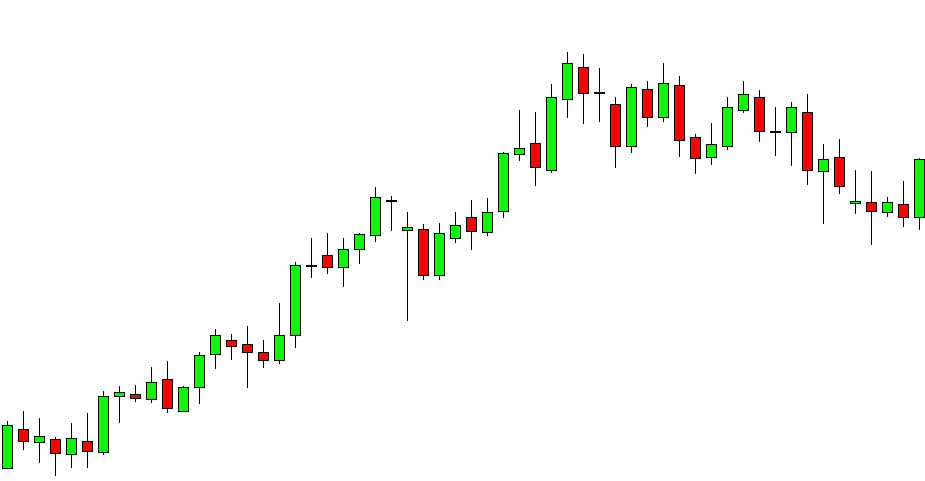
What is the Difference Between Candlestick Charts and Bars?
Bars and candlestick charts are both used for technical analysis to study the supply and demand of a security or commodity in a marketplace and represent the trading range of a security.
Bar charts have a small tick symbol on the left side to represent the opening price and a small tick on the right side to indicate the closing price.
As for a candlestick chart, it has a body and shadows or what are also called wicks. Bodies are defined as the range between the opening and closing price. Shadows represent the range of the day outside of the opening and closing of the prices.
As you can see in the example below, there are bar charts on the left and candlesticks on the right.

Mastering Candlestick Charts
Candlestick patterns are an efficient way for you to view an asset's price chart. It shows how the price moved during a specific period of time using colors and how far the price moved during that period.
Time frames are shown for the time frame you are using or have selected. For example, if you are using a 5-minute time frame, a candle will show the HIGH, LOW, OPEN, and CLOSING in 5 minute intervals.
Bullish Candle and Bearish Candle
Bullish and bearish represents buyers and sellers.
The intra-session high represents bulls, and the intra-session low represents the bears. If the close is closer to high, then the bulls are in control. If the close is closer to the low, then the bears are in control.
A bullish candle shows that the price has increased over the set time period. For the bearish candle, it shows that the price has decreased over the time period. Each fully formed candle represents the price action of a specific time period.
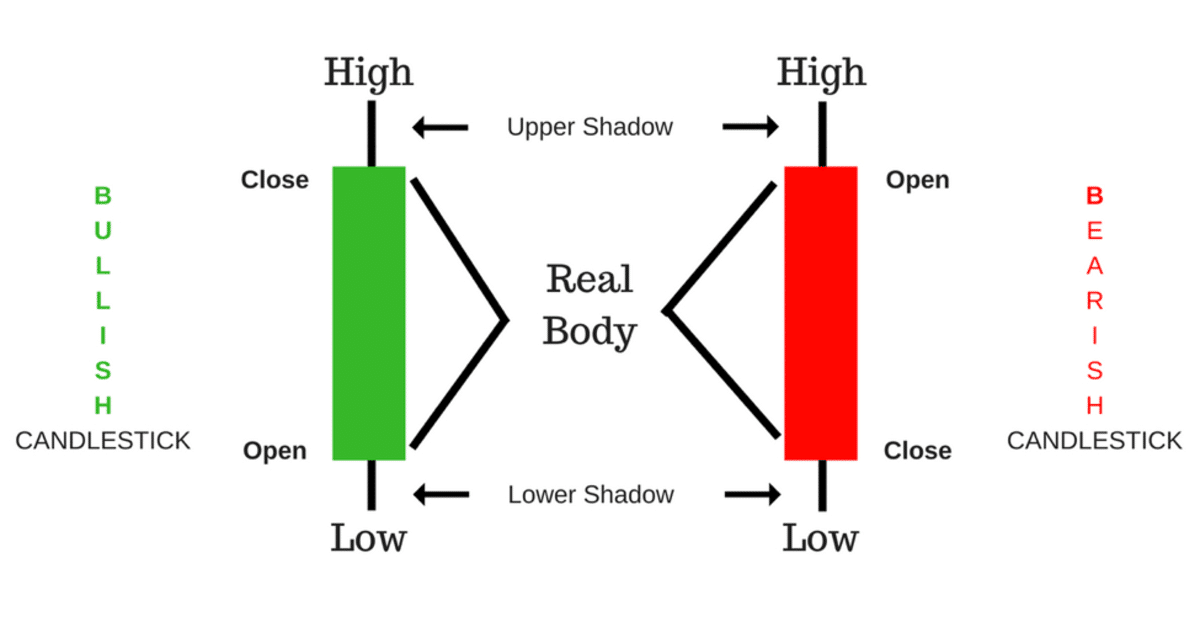
Candlesticks have two parts, a real body and a wick (tail). The open and close prices are the first and last transaction prices of that time frame. If no real body was shown, or the real body is tiny, then it means that the open and close are almost the same. Also, real bodies have color but differ in every charting platform.
The most common color of real bodies is green, red, white, and black. However, you can change this to your liking.
A green or white candle means the price finished higher or the closing price is above the open price. A red or black candle means that the price has decreased over the time period, or the top of the real body is the open price, and below is the closing price.
The bullish candle and the bearish candle similarly reflect the difference between the open and close price during that period.
Most charting platforms allow you to make adjustments to your candlesticks to be visually appealing and easily identifiable.
You can alter the colors of your up and down candles to make the contrast distinct.
What are Some of the Best Candlestick Chart Patterns?
Bullish Engulfing Candlestick
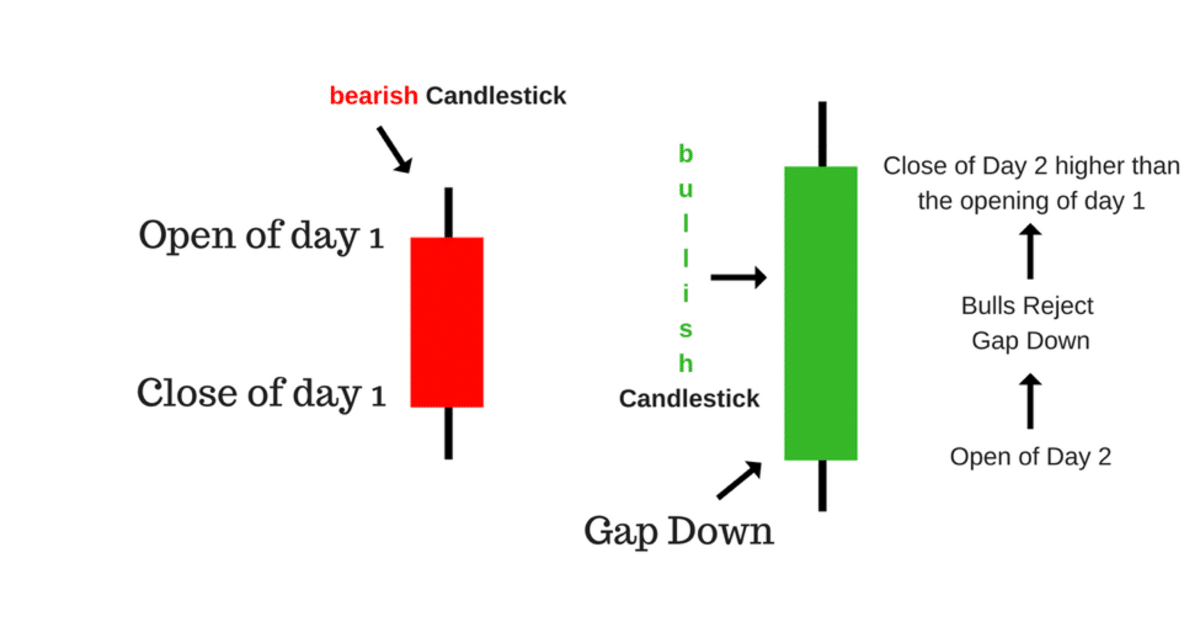
Quite a name for a candlestick. This pattern consists of two candles and shows when the price of a security moves beyond the high and low of the previous sessions range. This candle is your signal for a sustained upward move or trend change back higher.
Doji Candlestick

A Doji candlestick is one of the most popular candlestick patterns. The Doji pattern usually has a very small body with a close near the open price. It also has a long wick formed to the high and low. This candlestick offers a heads up that the sentiment may be changing.
Harami Candlestick
The bullish and bearish harami is a two candlestick pattern that is considered a reversal pattern.
For a bullish reversal, the first candle needs to be a large bearish candle. A small bullish candle then follows this.
For a bearish harami, the inverse needs to occur. The first candle needs to be a strong bullish candle followed by a smaller bearish candle.
Bearish Engulfing Candlestick
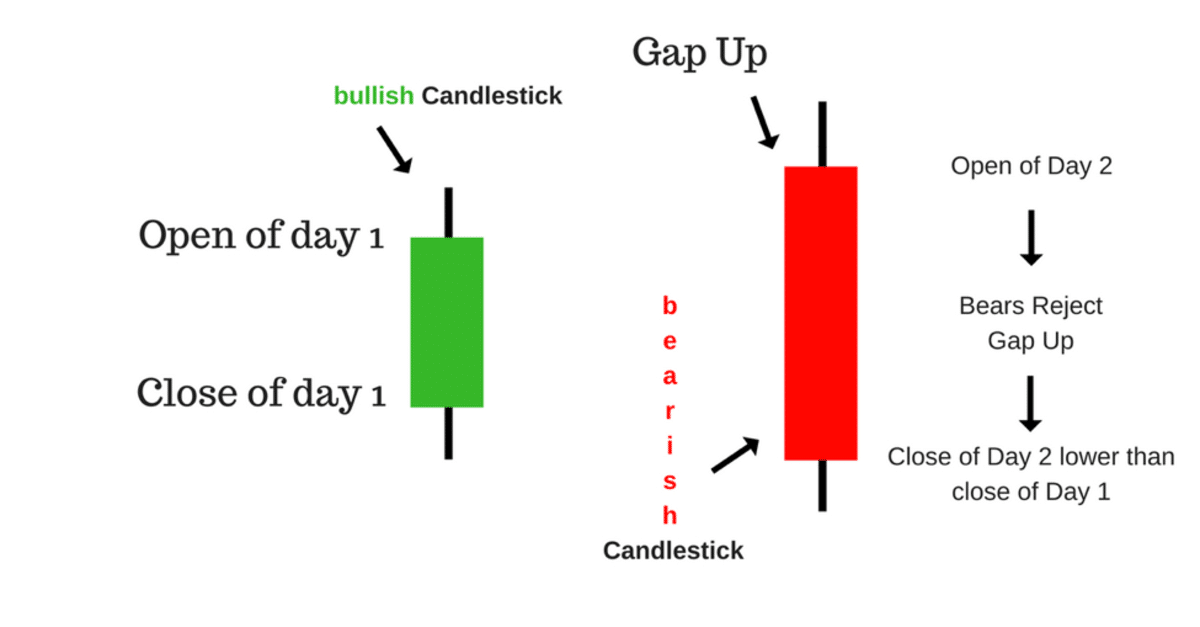
This pattern is the opposite of the bullish engulfing candle.
This can be a precursor to a sharp, sustained drop and indicate a potential reversal, or trend change back lower is about to occur.
FREE PDF Guide: How to Trade Candlestick Patterns PDF Guide Download
Hammer Candlestick Pattern
The hammer candlestick pattern signals a potential reversal higher after the price has recently made a swing lower.
A hammer is formed with;
- A small candlestick body
- A long wick or shadow that points lower
- Price finishes in the top quarter of the candlestick.
See the example below of how price formed a hammer pattern right before reversing back higher.

Inside Bar Pattern
The inside bar pattern is a pattern you will see on all of your different markets and time frames. It is very common and can be traded in a few different ways.
For an inside bar to be valid, you will need to see the candlestick form completely within the previous candlestick.
This candle can signal both a potential reversal or a continuation depending on where and how it is formed within the price action.
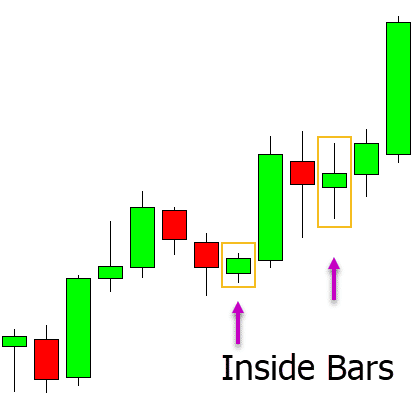
Shooting Star Candlestick Pattern
The shooting star pattern is not as common as some other candlestick patterns, but it is one of the more powerful.
This pattern signals a potential reversal back lower after the price has been rising higher.
The example below shows a shooting star example and how price forms a large upper wick and a small real body. Price then sells off back lower, completing the reversal.
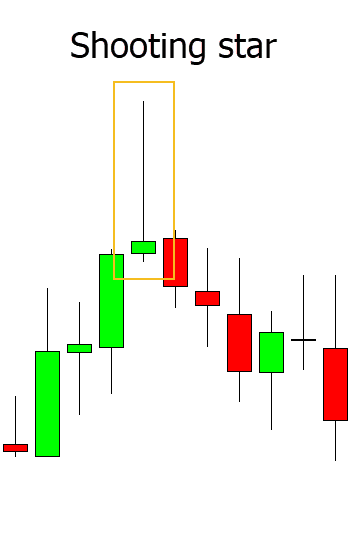
Using Advanced Candlestick Patterns
One of the best features of candlestick charting is that it helps you visualize market movements without overpopulating your monitor with numbers or complicated indicators and news feeds.
Because of the candlestick, you can quickly understand what's going on with a security price at a single glance.
You can also tell whether the sellers or buyers have dominated on a given day along with the sense of the trend. It is an excellent way for traders to identify and decide when is the best time to buy, sell, or wait.
After learning how to use and read the candlestick basics, you can easily start to spot the opening and closing price of a security and see patterns forming.
You can then begin using more advanced patterns like the hanging man candlestick pattern in your trading.
One of the major bonuses of using candlesticks in your trading is that you can start to use more and more advanced patterns as you start to become better at using them. Whilst one and two candlestick patterns are commonly used, you can start to use other patterns like the head and shoulders pattern and the 123 reversal pattern.
High Profit Candlestick Patterns
As we are about to go through, some of the most high profit candlestick patterns and trading strategies are when you use confluence.
Whilst candlesticks can be successfully used by themselves, they are often far better when combined with other strategies and indicators. These can include using your other favorite indicators or technical analysis tools to confirm high probability trades.
Candlestick Patterns Trading Strategy
Whilst there are endless ways you can use candlestick patterns with other indicators and price action methods, you will often find that the simplest strategies will work the best. These strategies include finding and trading with the obvious trends and trading from key market support and resistance areas.
Using Candlestick Patterns With the Trend
As the old saying goes, the trend is your friend until it bends. This is the same when using candlesticks in your trading. You can use the trend to find and make very high probability trades.
After you have found a clear trend, you can use your favorite candlestick patterns to fine-tune your entry signal.
An example of how you could do this is on the chart below. Price has been in a strong trend lower. When we notice price pullback higher into a value area, we start to look for short trades. Short trades could then be entered when price forms a bearish engulfing bar signaling a reversal back lower.
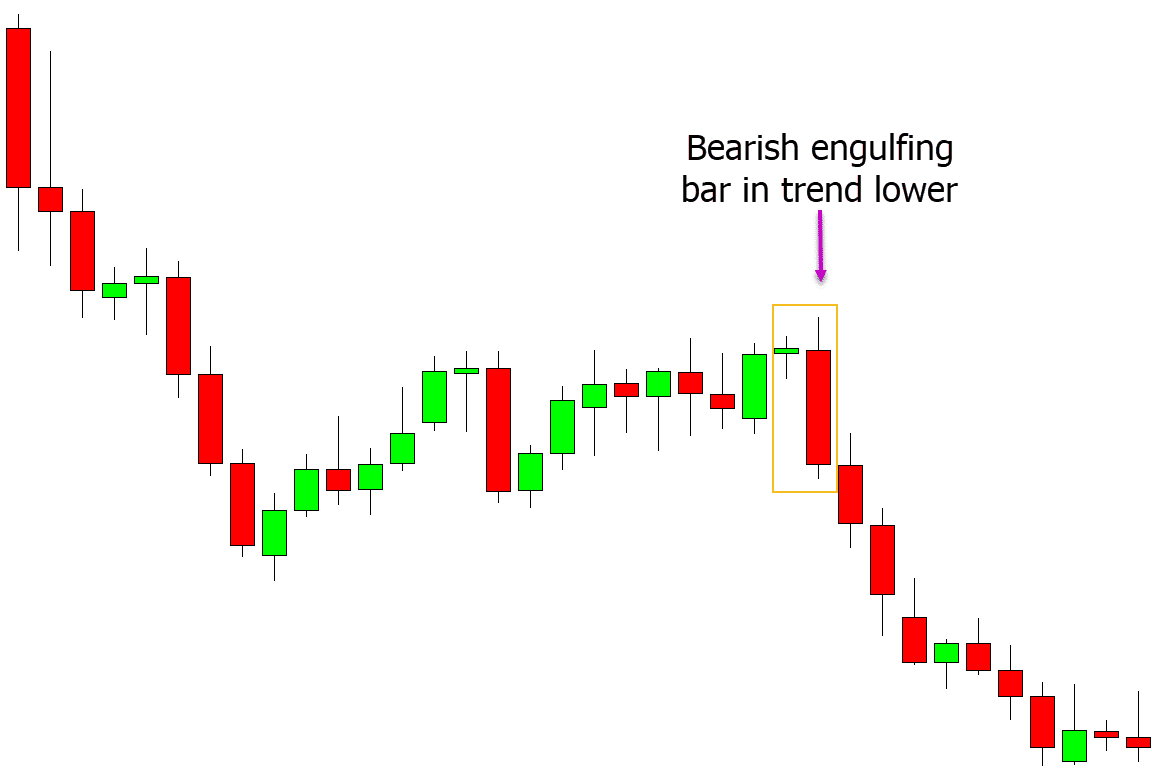
Using Candlestick Patterns at Key Support and Resistance Levels
Another successful way to use candlesticks in your trading is with key support and resistance levels.
In the example below, the price has repeatedly rejected an important resistance.
When price moves up to this level again and forms a bearish engulfing bar, we could make short trades and profit as price moves away from this resistance level.
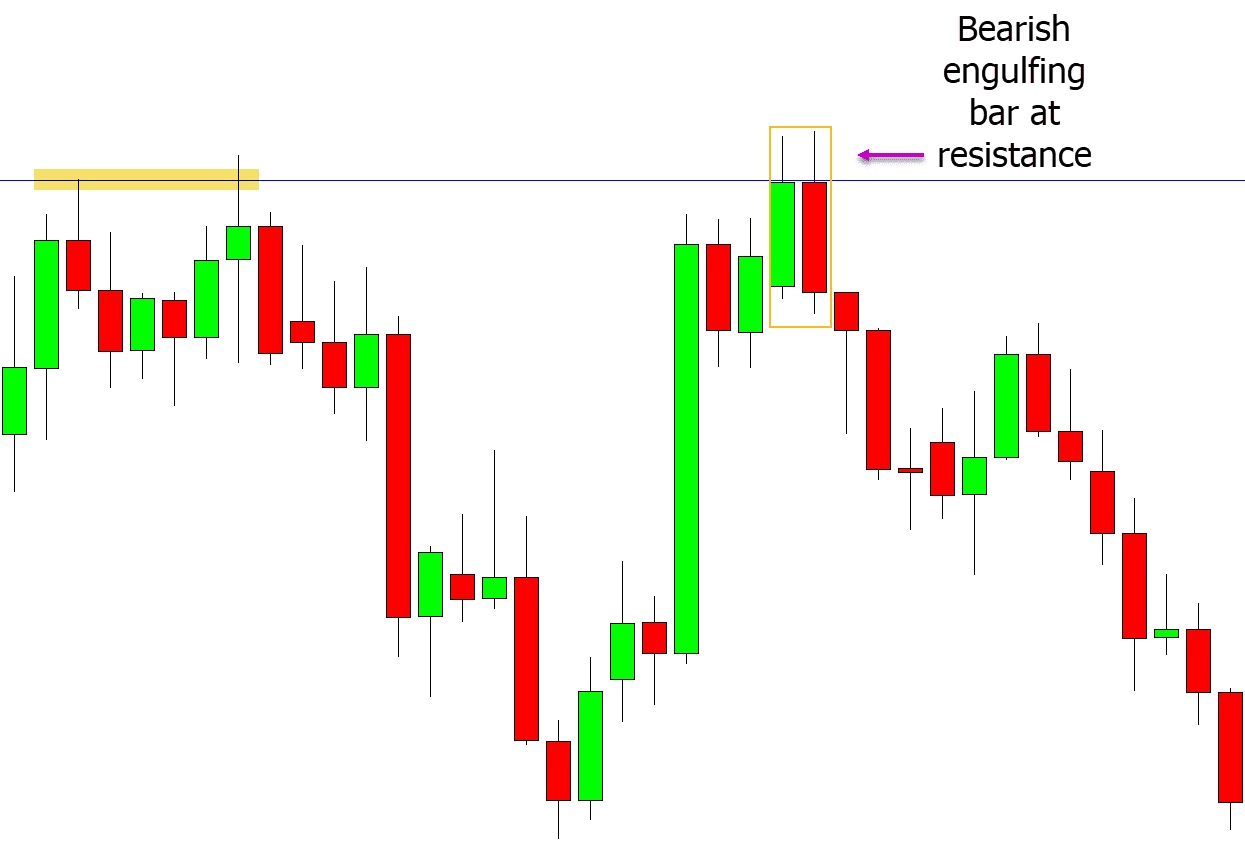
FREE PDF Guide: How to Trade Candlestick Patterns PDF Guide Download
Featured Brokers
XM Broker
- Tightly regulated around the world
- Latest MT4 and MT5 Platforms
- Small Minimum Deposit
- Superior trader support
- Over 5,000,000 Traders
I hunt pips each day in the charts with price action technical analysis and indicators. My goal is to get as many pips as possible and help you understand how to use indicators and price action together successfully in your own trading.
Posted by: alonsoalonsoschwanbeckea0252125.blogspot.com
Source: https://learnpriceaction.com/candlestick-patterns/
free Carp Fishing Ebooks Download Pdf
2020-22 Fishing Guide Printable Version (pdf) | Proclamation
Table of Contents
- Licenses
- Fees
- New for 2020-22 Fishing Seasons
- Fillet Transport Rules FAQ
- General Regulations
- Bait Definitions and Regulations
- Manner of Taking
- Hook and Line Fishing
- Open Areas and Season Dates
- Statewide Daily and Possession Limits and Exceptions
- Specific Regulation Information
- Fish Size Restrictions
- Red and Bois de Sioux Rivers
- Ice Fishing Regulations
- Fish Houses
- Darkhouse Spearfishing
- Archery and Spearfishing
- Underwater Spearfishing
- Paddlefish
- Hook and Line Fishing
- Aquatic Nuisance Species Rules and Q/A
- Informational
- Fish Length-Weight Table
- Whopper/Catch and Release Requirements
- Whopper and Catch and Release Minimums
- First Fish Award
- North Dakota State Record Fish Requirements
- North Dakota Record Fish
- Reporting Tagged Fish
- Boating Information
- Restrictions
- Regulations
- Aquatic Nuisance Species Sticker
- Fishing Waters
Licenses
These regulations are in effect for two years from April 1, 2020 through March 31, 2022. A fishing year is defined as April 1 of one calendar year through March 31 of the following calendar year. NOTE: In the event of emergency changes to the 2020-22 proclamation, Game and Fish will alert the media and public and post new information on the Department's website.
Licenses are valid for one year starting April 1 and ending March 31 of the following year. An angler must possess a valid fishing license for the respective season.
Residents and nonresidents age 16 and older need valid licenses. Residents under age 16 may take and possess a limit of fish without a fishing license. Any nonresident under age 16 may take and possess a limit of fish without a nonresident fishing license if accompanied by an individual possessing a valid fishing license.
Residency qualifications and a waiver of residency form are available on the Department's website. Call 701-328-6300 for more information. North Dakota residents who are on leave while on active duty with the United States military can fish without a license. Contact the Department for details.
Nonresident full-time students living in North Dakota, who are attending a state or tribal college, or a private institution of higher education, may qualify for purchasing resident fishing licenses. Contact the Department for details.
The fishing license (paper or electronic form) must be in possession of the licensee at all times while fishing and available for inspection.
Free Fishing Days – Residents of North Dakota may fish without a resident fishing license on June 6-7, 2020, December 26-27, 2020; June 5-6, 2021 and December 25-26, 2021.
| Fee | Amount |
|---|---|
| Resident Fishing, Hunting and Furbearer Certificate | $1 |
| Resident Individual* | $18 |
| Resident Married Couple* | $24 |
| Resident, 65 years or older | $5 |
| Resident, Totally or Permanently Disabled** | $5 |
| Resident, 50 percent or more Disabled Veteran** | $5 |
| Resident Combination License (16 years or older – includes fishing, small game, general game and habitat, and furbearer licenses)* | $52 |
| Nonresident Fishing, Hunting and Furbearer Certificate | $2 |
| Nonresident Individual* | $48 |
| Nonresident Married Couple* | $63 |
| Nonresident 10 Days* | $38 |
| Nonresident 3 Days* | $28 |
| All paddlefish snaggers must possess a valid paddlefish tag in addition to required licensing. A resident paddlefish tag is $10, a nonresident paddlefish tag is $25.50. *Fees include license costs and ANS surcharge. **Available only from the Department's Bismarck office. | |
New for 2020-22 Fishing Seasons
Lake Ashtabula and Whitman Dam are added to the list of waters where darkhouse spearfishing is not allowed.
The State Fair Pond will be open to fishing year round except for the 2-3 weeks immediately prior to the State Fair. Fish can be harvested at the State Fair Pond year round except from April 1-July 31.
The smallmouth bass daily limit is increased from 3 to 5 in the Missouri River and lakes Sakakawea, Oahe, Audubon, Darling, Ashtabula and Heart Butte.
For fish hooked by a lure with multiple hooks, the fish is not considered foul-hooked if at least one of the hooks is embedded from gill covers forward.
Area and time for paddlefish extended snag/release days is expanded.
Individuals who are not required to possess a valid fishing license (e.g. less than 16 years old) do not need to register prior to participating in darkhouse spearfishing.
Fillet Transport Rules
Fish may be filleted for transport, unless size limits apply, under the following conditions:
- Each individual portion of the meat removed from a fish is considered a fillet*,
- Two fillets are counted as one fish, and
- The packaging of fish must be done in a manner so that the fillets can be readily separated and counted. If fillets are frozen, they must be packaged so that the fillets are separated and thus can be easily counted without thawing.
- View fillet transport rules FAQ.
*Fish cheeks and pectoral girdles (wings) are not considered as fillets and are legal to transport.
General Regulations
Fish Definitions
Game fish are bluegill, burbot, channel catfish, chinook salmon, crappie (black and white), largemouth bass, muskellunge (pure and hybrid), northern pike, paddlefish, sauger, saugeye, smallmouth bass, sturgeon (pallid, shovelnose and lake), trout (brown, lake, rainbow and cutthroat), walleye, white bass, yellow perch and zander.
Legal live baitfish are fathead minnows, creek chubs, sticklebacks, white suckers and rainbow smelt. See Section 4 for use and possession.
Nongame fish are all species that inhabit and reproduce in the state's waters that are not listed above as game fish or legal live baitfish.
Wanton Waste – no individual possessing any game fish species may waste, destroy or abandon the edible flesh (fillets).
It is illegal to deposit, or cause to be deposited, any fish or parts thereof, upon the ice, in the water, or upon the shore of any water body in North Dakota.
Depositing or leaving any litter (including refuse, bottles, cans, etc.) or other waste material in the water, on shore or on the ice is illegal.
It is illegal to introduce anything into waters of the state for the purpose of attempting to attract fish (e.g. chumming, artificial light, acoustic equipment, etc.) that is not attached or applied to a lure as defined on page 12. Decoys used while darkhouse spearfishing are excluded.
Other than landing a fish caught on hook and line equipment, netting or trapping fish is illegal except for legal live bait as defined on page 8.
No individual or entity may conduct a fishing contest on any public waters without first obtaining a permit issued by the Game and Fish director.
Stocking of any live fish, live fish eggs, live amphibians, or other live aquatic organisms into any waters of the state is illegal except with the appropriate license or permit issued by the Game and Fish director.
Transportation of any live fish, live fish eggs, live amphibians or other live aquatic organisms is illegal except for:
- Anglers transporting legal live baitfish and legal live aquatic bait (see following sections).
- Dealers and buyers of tropical fish species for the pet trade sold at commercial outlets.
The director may make reasonable accommodations to comply with the Americans with Disabilities Act.
No individual shall sell, or take for the purpose of sale, any fish (including baitfish) except as allowed in bait or commercial fishing laws.
No fish species may be transported in water away from the water body from which they were taken. Ice in a cooler or other container may be used in transporting fish.
It is illegal to remove more than gills, entrails and scales from fish species harvested in waters that are subject to a size limit while on the water or actively engaged in fishing. It is illegal to remove more than the gills and entrails (head, fillets and tail must be attached) from channel catfish east of ND Highway 1 while on the water, actively engaged in fishing, transporting or until the fish are at the license holder's residence.
Fish may be filleted for transport, unless size limits apply, under the following conditions:
- Each individual portion of the meat removed from a fish is considered a fillet*,
- Two fillets are counted as one fish, and
- The packaging of fish must be done in a manner so that the fillets can be readily separated and counted. If fillets are frozen, they must be packaged so that the fillets are separated and thus can be easily counted without thawing.
*Fish cheeks and pectoral girdles (wings) are not considered as fillets and are legal to transport.
Any fish (whole and/or fillets) may be given (gifted) to another individual, but the fish must be counted in the donor's daily limit. Individuals who receive gifted fish may not exceed the possession limit while the fish are being transported.
Gifted fish, including packages of fish, must be accompanied with the following information from the individual gifting the fish: name, fishing license number, phone number, date, species and number of fish gifted.
Except for legally gifted fish, it is illegal to possess or transport another individual's game fish or parts thereof without the license holder accompanying or as otherwise permitted.
Commercial processors, common carriers and common storage areas may possess any individual's legally taken possession limit of fish. Each package must be labeled with the owner's name and address.
The North Dakota Department of Environmental Quality has issued advisories for the consumption of fish from certain North Dakota lakes and rivers. These fish contain levels of mercury which may be harmful to women of childbearing age and young children if they are eaten too often. Information listing current consumption advice is available from the Department of Environmental Quality website at Fish Consumption Advisory or by calling 701-328-5150.
Bait Definitions and Regulations
Legal live aquatic bait are leeches; native frog, salamander and crayfish species; and the following legal live baitfish species: fathead minnows, creek chubs and sticklebacks. In addition, live white suckers are legal aquatic baitfish in the Red and Bois de Sioux rivers only. Live rainbow smelt are legal aquatic baitfish when captured and used in the Missouri River System only with a dip net, minnow trap or by hand.
All other species of live aquatic bait are illegal.
The use of game fish and parts thereof is illegal, except for yellow perch eyes, and trout and salmon eggs.
All aquatic bait noted in this section, and nongame fish, which have been frozen, salted, preserved or cut into pieces (to include heads, entrails, etc.) are legal bait.
All terrestrial bait (live or dead) such as nightcrawlers and waxworms are legal.
Products manufactured as edible fishing bait and other inert biodegradable substances are legal bait.
No live baitfish (e.g. fathead minnows) may be used or possessed on the waters listed below. All other legal live bait (e.g. nightcrawlers, leeches, etc.) can be used.
| Water Area | County |
|---|---|
| Belfield Pond | Stark |
| Blumhardt Dam | McIntosh |
| Bylin Dam/Dougherty Dam | Walsh |
| Camels Hump Lake | Golden Valley |
| Crown Butte | Morton |
| Custer Mine Pond | McLean |
| Davis Dam | Slope |
| Dickinson Dike | Stark |
| Fish Creek | Morton |
| Harmon Lake | Morton |
| Indian Creek | Hettinger |
| Kettle Lake | Williams |
| Leland Dam | McKenzie |
| Lightning Lake | McLean |
| McDowell Dam | Burleigh |
| Mott Watershed | Hettinger |
| Nelson Lake | Oliver |
| North Lemmon Dam | Adams |
| Nygren Dam | Morton |
| Raleigh Reservoir | Grant |
| Ryan Park Pond | Grand Forks |
| Sather Dam | McKenzie |
| Sheep Creek Dam | Grant |
| Velva Sportsmen's Pond | Ward |
For the Red and Bois de Sioux rivers up to the first vehicular bridge or crossing on any of their tributaries: legal live baitfish are fathead minnows, creek chubs, sticklebacks and white suckers.
Statewide – in all other water bodies of North Dakota (not listed on page 7), the only legal live baitfish are fathead minnows,creek chubs and sticklebacks.
Exception – rainbow smelt may be taken on the Missouri River System; however, all smelt taken must be dead when transported.
All legal live aquatic bait used by anglers, including legal baitfish, must have been purchased or trapped in North Dakota. No live aquatic bait may be imported into the state by anglers. This includes live baitfish and leeches.
Anglers may not transport water, including that used for bait (e.g., bait buckets, etc.), away from waters of the state designated as infested with Class 1: Prohibited Aquatic Nuisance Species; currently, this ncludes the Red River, Lake Ashtabula and the Sheyenne River downstream of Lake Ashtabula. See the ANS Infested Waters page for current list of lakes. All water must be drained from bait buckets as anglers leave the shore or remove their boat from the water. Anglers must properly dispose of unused bait away from the river, as dumping bait in the water or on shore is illegal.
In all other waters of the state, legal live baitfish and other legal live aquatic bait may be transported in water but only in containers of five gallons or less. Any container (e.g. bait bucket) used to hold bait must be free of aquatic vegetation.
The transportation of live white suckers, other than in Richland, Cass, Traill, Grand Forks, Walsh and Pembina counties, is illegal.
It is illegal to possess more than an aggregate of 150 legal live baitfish. See page 11 for list of limits.
All individuals selling live aquatic bait must possess a bait vendors license.
Licensed anglers may trap their bait but may not use more than one minnow trap and/or one dip net for taking smelt or legal live aquatic bait. The trap may not exceed 12 inches in diameter and 30 inches in length, with a throat opening not to exceed 1-1/4 inches. Dip nets may not exceed 24 inches in diameter or 36 inches in depth. All other nets (e.g. cast) are illegal.
Legal live bait and legal live baitfish may be taken in all public waters of the state except for the following:
- Those water bodies listed on page 7 as "no live baitfish" lakes.
- Recent water bodies that may have been designated as infested with pohibited or regulated aquatic nuisance species – current list of lakes.
- James River between Jamestown Dam and the South Dakota border.
- Sheyenne River downstream of Lake Ashtabula to the Red River.
- Red River and Bois de Sioux rivers.
- Missouri and Yellowstone rivers*.
- Lake Sakakawea*.
- Lake Oahe*.
- Lake Audubon.
- Lake Metigoshe.
- McClusky Canal including New Johns, Heckers, East Park and West Park lakes.
- McDowell Dam.
- Raleigh Reservoir.
*Exception – rainbow smelt may be taken on the Missouri River System; however, all smelt taken must be dead when transported.
It is illegal to use live rainbow smelt for bait anywhere except for the Missouri River System.
It is illegal to possess, or possess with intent to sell, or to use as live baitfish, any species other than fathead minnows, creek chubs, sticklebacks and white suckers. The penalty for fishing with or possession of an illegal live baitfish is $250.
Manner of Taking
Each angler must take his or her own fish. Party fishing is illegal.
The daily creel limit is defined as the maximum number of legally taken fish (by species) that may be harvested from midnight to midnight. No individual may harvest or possess more than North Dakota's daily limit of fish while on the water, ice or actively engaged in any manner of fishing.
The possession limit is defined as the maximum number of legally taken fish (by species) that an individual may have in their actual possession during any phase of any single fishing trip of more than one day. At no time may an individual transport more than a possession limit without written approval of the Game and Fish director.
The storage limit at one's residence is unlimited. It is illegal to take, possess or transport any of the following species of fish in North Dakota (they must be immediately released back into the water from which they were caught): pallid sturgeon, shovelnose sturgeon and lake sturgeon.
It is illegal to take paddlefish at any time except as provided on pages 19-21.
Turtles may not be taken commercially in North Dakota.
The season on clams (freshwater mussels) remains closed in North Dakota.
Taking or attempting to take fish from North Dakota waters is limited to the following methods only: Hook and Line Fishing, Darkhouse Spearfishing, Archery (Bow) and Spearfishing, Underwater Spearfishing and Paddlefish Snagging. All other manners of taking (e.g. "jugging," "noodling," and use of trot [set] lines, etc.) are illegal. The following pages provide detailed manner of taking regulations.
Hook and Line Fishing
Open Areas and Season Dates
ALL WATERS of the state are open to fishing year-round except below.
| |
| Area | Season |
|---|---|
| OWLS Pond; State Fair Pond | Closed to fishing at night (sunset to sunrise). |
| Lightning Lake; McDowell Dam | Closed to all ice fishing. Open to all open-water fishing. |
| State Fair Pond | Closed July 4 to July 16, 2020, and July 4 to July 22, 2021. |
| Portions or all of the following waterfowl rest areas: North Golden Lake, Sheyenne Lake | Closed to all fishing September 20 through November 30, or when conditions allow for ice fishing (whichever comes first). Open to all fishing all other times. |
| All national wildlife refuges and easement national wildlife refuges are closed to fishing except the following (contact refuge headquarters for designated open areas and special restrictions): | |
| Arrowwood, J. Clark Salyer, Lake Darling (and all waters within the Upper Souris refuge boundary), Lake Ilo, Long Lake and Tewaukon national wildlife refuges | Open to shore and/or ice fishing April 1 through March 31 in designated areas. Open to boat fishing May 1 through September 30 in designated areas. Closed to all boating October 1 through April 30. |
| Lake Alice and Lake Audubon (southern half of lake) national wildlife refuges | Open to ice fishing only. Closed to all other fishing and all boating. |
| Dakota Lake, Hobart Lake and Sibley Lake (Griggs County) easement national wildlife refuges | Open to all fishing April 1 through September 30 and December 1 through March 31. Closed to all fishing and boating October 1 through November 30. |
| Lake Ardoch, Rose Lake, and Silver Lake (Benson County) easement national wildlife refuges | Open to shore and/or ice fishing from April 1 through March 31. Contact refuges for specific areas and times open to boat fishing. |
Statewide Daily and Possession Limits and Exceptions
| Species | Daily Limit | Possession Limit |
|---|---|---|
| Walleye, Sauger, Saugeye or Combination (a) | 5 | 10 |
| Northern Pike | 5 | 10 |
| Yellow Perch | 20 | 40 |
| White Bass | 20 | 40 |
| Bluegill | 10 | 20 |
| Crappie | 10 | 20 |
| Trout | 3 | 6 |
| Salmon | 5 | 10 |
| Burbot (Ling) | 10 | 20 |
| Channel Catfish - East of ND Hwy. 1 (b) | 5 | 5 |
| Channel Catfish - West of ND Hwy. 1 | no limit | no limit |
| Largemouth Bass, Smallmouth Bass or Combination | 3 | 6 |
| Muskellunge (pure or hybrid) | 1 | 1 |
| Paddlefish | See pages 19-21 | |
| Nongame Fish (other than legal live baitfish) | no limit | no limit |
| Legal Live Baitfish (c) | 150 | 150 |
| Leeches | 300 | 300 |
| Smelt | 5 gallons | 5 gallons |
| Frogs | 24 | 24 |
| Salamanders | 24 | 24 |
| Crayfish | 48 | 48 |
| Snapping Turtle (d) | One annually | |
| a–Zander are included as part of the walleye, sauger, saugeye combination in Spiritwood and Alkali Lakes (Stutsman Co.). b–In the Red and Bois de Sioux rivers, the limit is 5 catfish regardless of the number of state or provincial licenses purchased by the angler. c–Aggregate of all legal species (see Section 4). d–Harvest legal only between July 1 and November 15. | ||
| Water | Exception |
|---|---|
| Red and Bois de Sioux rivers up to the first vehicular bridge or crossing on any of their tributaries | NORTHERN PIKE – Daily 3, Possession 3 WALLEYE, SAUGER, SAUGEYE OR COMBINATION – Daily 3, Possession 3 |
| Lightning Lake | TROUT – Catch and release only from April 1 through June 30 |
| OWLS Pond | ALL SPECIES – Catch and release only |
| State Fair Pond | ALL SPECIES – Catch and release only from April 1 through July 31 |
| Kraft Slough | YELLOW PERCH – Daily 10, Possession 20 |
| Missouri River, lakes Sakakawea, Oahe, Ashtabula, Audubon, Darling and Tschida | SMALLMOUTH BASS – Daily 5, Possession 10 |
| Fish size restrictions | |
Specific Regulation Information
With the exceptions noted immediately below, legal hook and line equipment for each angler shall consist of not more than two poles, each equipped with one line, in the water at any one time. Each line in the water may have zero, one or two lures attached.
Exceptions:
- Only one pole is legal at the Garrison Dam Tailrace (Missouri River) while fishing from the piers and wing walls.
- Only one pole is legal at the Drayton Dam (Red River) while shore-fishing between the boat ramp and area designated "closed to fishing."
- Four poles are legal while ice fishing.
Note: When fishing a water body where both open water and ice fishing occur at the same time, an angler is allowed a maximum of four poles, of which no more than two poles can be used in open water. See page 15 for additional ice fishing regulations.
A lure is defined as any man-made object comprised of metal, plastic, wood and/or other nonedible materials made or used to catch fish. A lure may not contain more than three hooks and the maximum distance between any hooks on a lure may not exceed 10 inches. A single hook may not include more than three points, barbed or otherwise. Spinners and other live bait rigs and harnesses are considered a lure and are legal. Hookless dodgers or attractors used ahead of a lure or bait or attached to a downrigger ball are legal.
Fishing poles must be easily visible and within a maximum distance of 150 feet of the participating angler. Fishing poles must be checked at least once per hour while fishing.
Any device directly connected to the fishing rod that sets the hook is legal as long as it does not reel in (retrieve) fish. The use of any device to automatically hook or retrieve fish is illegal.
After a fish is caught on hook and line, it is legal to return all fish to the water at the site of capture if done in no longer than the time needed to unhook, measure and/or photograph the fish immediately after being caught. Fish returned to the water should show no evidence of bleeding, be handled carefully, and not thrown or dropped. All fish released from bridges and wing walls (e.g. Garrison Dam Tailrace) must be done immediately after being placed in a fish basket/open container to ensure fish survival.
High-grading or culling of fish is illegal. No fish may be returned to the water after being held on a stringer or confined by or in any type of holding structure, except in the case of approved live-release fishing tournaments and only with written permission from the Game and Fish director. No fish may be released into any waters other than the one from which it was originally caught.
A foul-hooked or snagged fish is defined as any fish hooked or caught in any area from behind the gill covers to the tail. For fish hooked by a lure with multiple hooks, the fish is not considered foul-hooked, if at least one of the hooks is embedded from the gill covers forward. Any foul-hooked or snagged fish must immediately be returned to the water regardless of condition. Possession of foul-hooked fish is illegal.
Attempting to snag fish is illegal.
Landing a fish caught on hook and line equipment with aid of a gaff is legal except for sturgeon, paddlefish, muskellunge and species in waters in which there are size limits. No gaffed fish may be returned to the water.
It is illegal to tag or mark any fish prior to release.
Lake specific rules may exist and may be displayed by Department signage at access areas and bridges.
Fish Size Restrictions
| Water Areas | It is Illegal to Take or Possess |
|---|---|
| Anywhere in the state | Muskellunge Less than 48 inches in total length |
| Lake Elsie (Richland Co.) | Walleye/Sauger Less than 14 inches in total length |
| Buffalo Lake (Sargent Co.) – including connected waters north to Sargent Co. Rd. 1 | |
| Jamestown and Pipestem reservoirs (Stutsman Co.) – upstream to and including the first bridge crossing | |
| All waters east of ND Highway 1 including the Red and Bois de Sioux rivers | More than 1 Channel Catfish greater than 24 inches in total length |
All undersized or oversized fish caught where there is a size limit, must be returned to the water immediately regardless of condition and must be handled carefully to avoid injury.
Page 14 North Dakota Fishing Guide – 2020-22 It is illegal to remove more than gills, entrails and scales from fish species harvested in waters that are subject to a size limit while on the water or actively engaged in fishing.
It is illegal to remove more than the gills and entrails from channel catfish east of North Dakota Highway 1 while on the water, actively engaged in fishing, transporting or until the fish is at the license holder's residence. Head, fillets and tail must be attached.
How to Measure the Length of a Fish
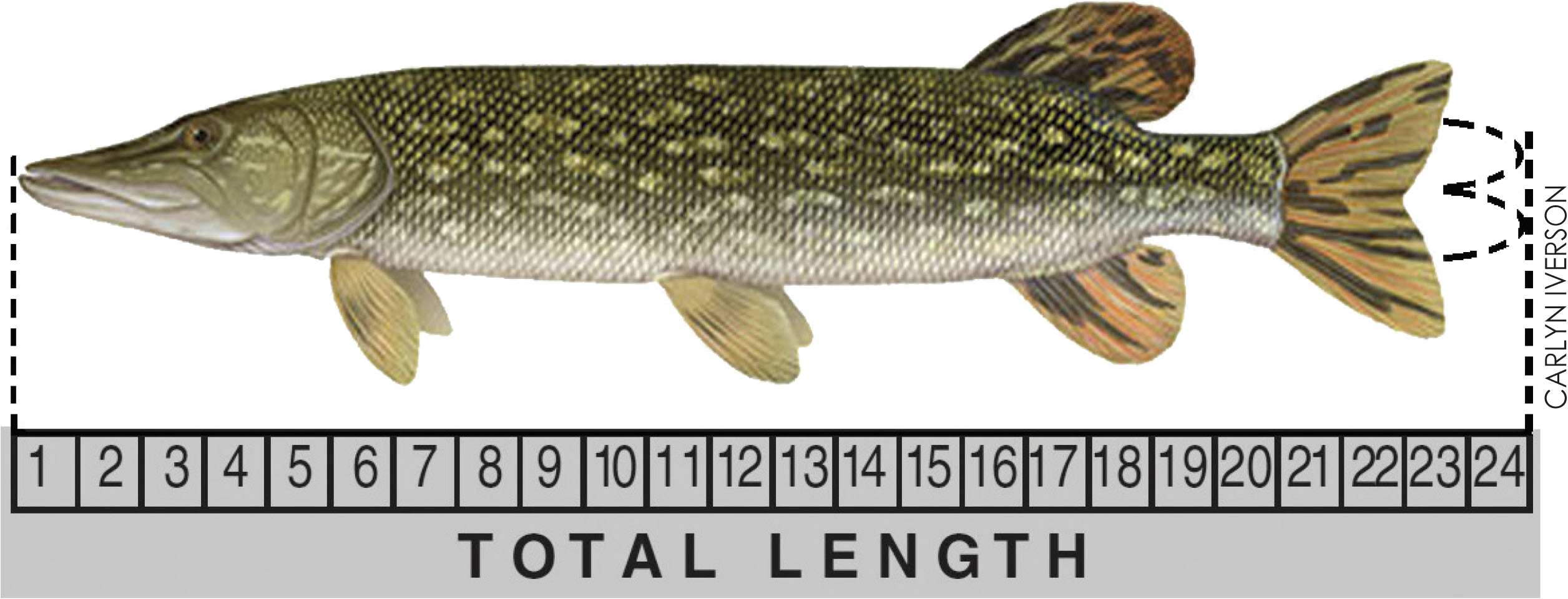
To determine the "total length" of a fish, lay it flat on its side with its mouth closed and measure from the nose to the tip of the tail when the tail lobes are pressed together.
Red and Bois de Sioux Rivers
Individuals fishing the Red River and/or the Bois de Sioux River in a boat or on the ice who possess a valid fishing license from either North Dakota or Minnesota may fish the river(s) between the banks separating North Dakota and Minnesota. Individuals fishing the Red River and/or the Bois de Sioux River on the shoreline must have a valid fishing license from the state in which they are fishing. Those individuals possessing the correct, valid license may transport caught fish by the most convenient and direct route to the state in which they are licensed. While on the water or ice, anglers must comply with the regulations of the state for which they are licensed. Upon leaving the water, all anglers and boaters are required to comply with aquatic nuisance/ invasive species, fish and bait transport regulations of the state they are in. (NOTE: this includes those who are not required to have a license).
For anglers fishing the Red and Bois de Sioux rivers (as well as all waters east of ND Highway 1), some daily and length limits differ from statewide regulations (see page 11). Also, due to the presence of zebra mussels, all water must be completely drained from (bait) containers, including bait buckets, upon leaving the Red River. This is in addition to the statewide aquatic nuisance species rules (pages 21-23).
Ice Fishing Regulations
Ice fishing is defined as hook and line fishing that occurs while on the ice. See page 10 for waters open to hook and line fishing.
A maximum of four poles is legal for ice fishing. However, when fishing a water body where both open water and ice occur at the same time, an angler is allowed a maximum of four poles, of which no more than two poles can be used in open water.
Fishing poles must be easily visible and within a maximum distance of 150 feet of the participating angler.
Tip-ups are legal for ice fishing. Each tip-up is considered a single pole.
There is no restriction on the size of the hole in the ice while ice fishing. When a hole greater than 10 inches in diameter is left in the ice, the area in the immediate vicinity of the hole must be adequately marked with a natural object or a brightly painted or colored wooden lath. Markers must be in possession of the angler as soon as a hole greater than 10 inches in diameter is made. Markers must be visible from a minimum of 150 feet.
Fishing holes outside a fish house may be placed no closer than 10 feet from the house without consent of the fish house occupant.
As a guideline, anglers should consider the following as the minimum thickness for safe loads on ice:
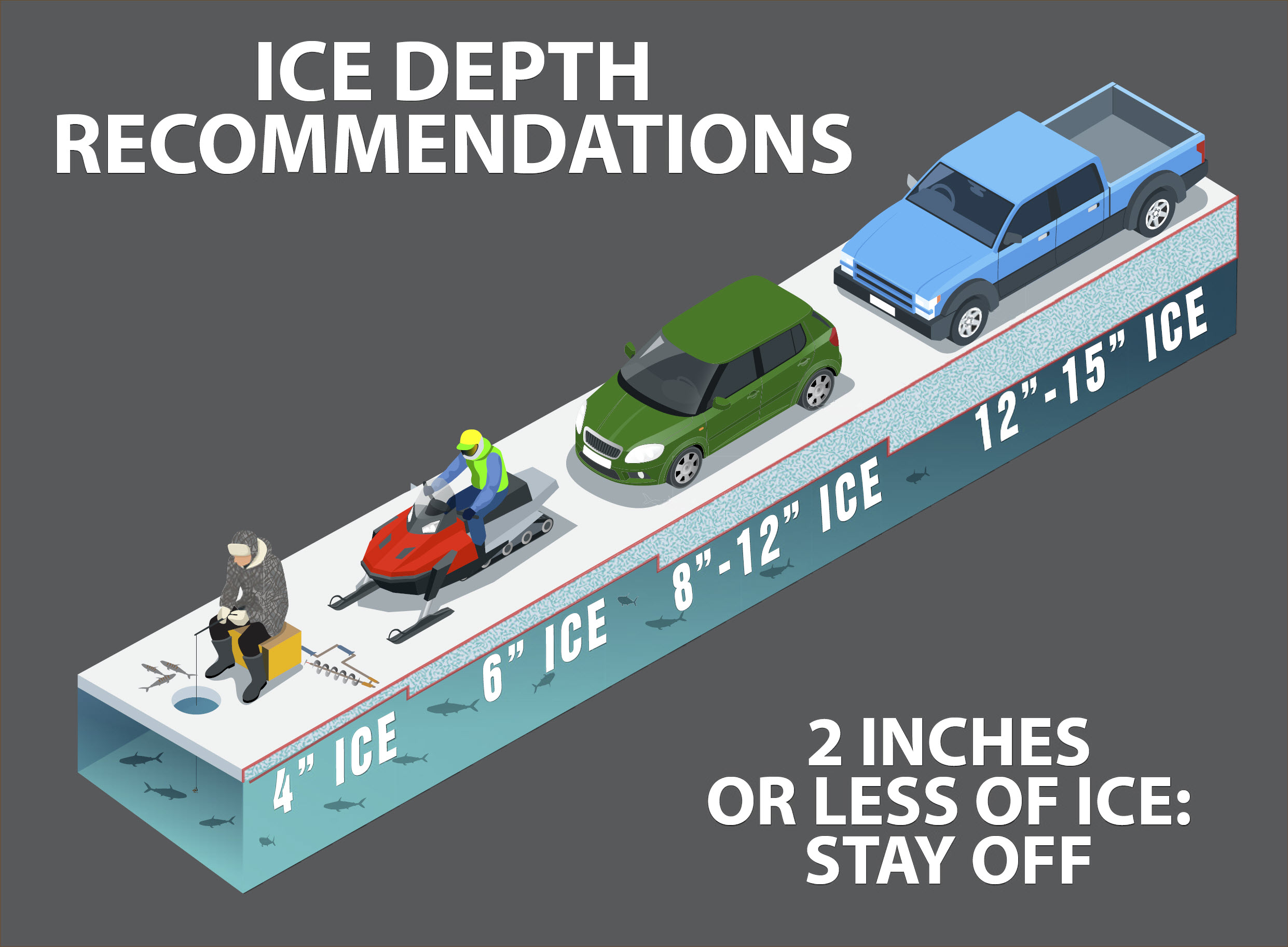
Please note: The Game and Fish Department does not monitor ice thickness
Fish Houses
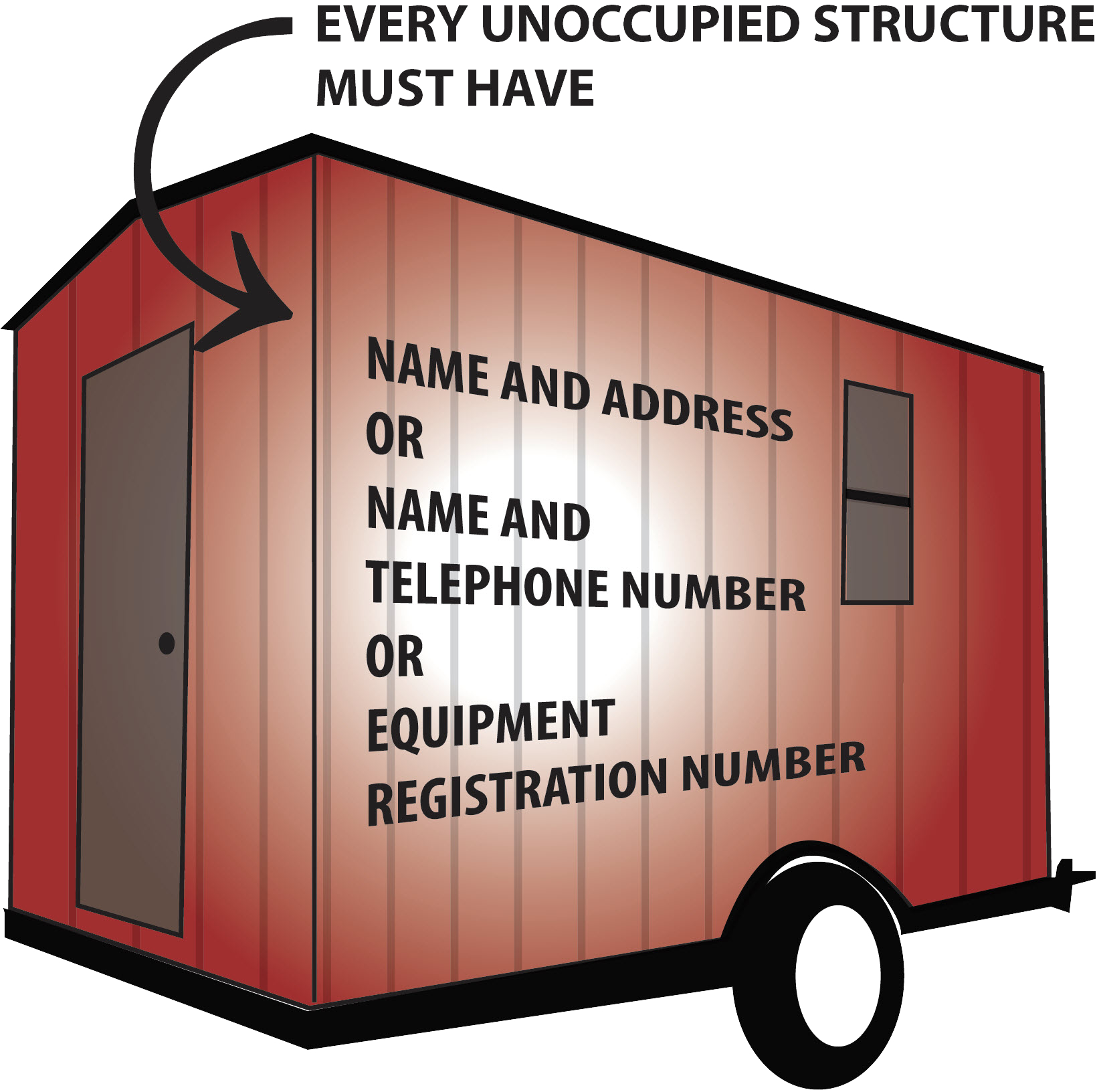
Licensing of fish houses is not required in North Dakota. However, any unoccupied fish house must have an equipment registration number issued by the Game and Fish Department, or the owner's name, and either address or telephone number, displayed on its outside in readily distinguishable characters at least three inches high. Any unoccupied fish house left on the ice without having this proper identification may be removed or destroyed by the Department, and its owner is guilty of a class 2 noncriminal offense.
Any structure used as a fish house or darkhouse (to include campers) that is required to have an equipment registration number, or the owner's name and address or telephone number inscribed on it, shall be constructed of material that will allow it to float and be readily removable from the ice at any time.
When in use, fish houses must be open for inspection at all times.
Fish houses may be placed no closer than 50 feet in any direction from another fish house, without consent of the other fish house occupant.
Fishing holes outside a fish house may be placed no closer than 10 feet from the house without the consent of the fish house occupant.
All unoccupied ice houses must be removed from all waters beginning March 15 until ice-out.
It is illegal to leave fish houses on any federal USFWS refuge land, Corps of Engineers land, Bureau of Reclamation land or on any state-owned or managed land after March 15 of each year.
Darkhouse Spearfishing
Northern pike and nongame fish are the only legal species for darkhouse spearfishing. Daily and possession limits are the same as listed on page 11.
Darkhouse spearfishing is legal from ice-up through March 15 of each fishing year.
All waters open to hook and line fishing are open to darkhouse spearfishing, except the following fishing waters, which are closed:
- East Park Lake – McLean Co.
- Heckers Lake – Sheridan Co.
- Lake Ashtabula – Barnes and Griggs Cos.
- Lake Audubon – McLean Co.
- Larimore Dam – Grand Forks Co.
- McClusky Canal
- New Johns Lake – Burleigh Co.
- Red Willow Lake – Griggs Co.
- West Park Lake – McLean Co.
- Whitman Dam – Nelson Co.
- Wood Lake – Benson Co.
Individuals who are required to possess the needed valid fishing license to participate in darkhouse spearfishing must first register online prior to participating.
It is illegal to return fish to the water after they are speared. Possession of a spear is counted as a hook-and-line fishing pole while darkhouse spearfishing. Legal darkhouse spear equipment shall be any manually powered shaft with barbed points. The spear head shall not exceed 12 inches in width. Pneumatic or rubber band powered spear guns may not be used. Artificials and all legal bait, with the exception of live white sucker and rainbow smelt, may be used as decoys. (Note: it is legal to use live white suckers as decoys on the Red and Bois de Sioux rivers up to the first vehicular bridge or crossing on any of their tributaries). Any line used for a decoy will be considered a hook-and-line fishing pole.
There is no restriction on the size of the ice hole while actively engaged in darkhouse spearfishing. When a hole greater than 10 inches in diameter is left in the ice when a darkhouse is moved, the area in the immediate vicinity of the hole must be adequately marked by the spearer with a natural object or a brightly painted or colored wooden lath. Markers must be in the possession of the angler as soon as a hole greater than 10 inches in diameter is made. Markers must be visible from a minimum of 150 feet.
Archery and Spearfishing
Game fish may not be taken with bow/arrows or spears.
It is illegal to return fish to the water after they are shot or speared. All fish must be used and/or disposed of properly and not left in the water or on land.
Archery fishing is legal from April 1 through March 31 of each fishing year.
Spearfishing is legal from May 1 through November 30 of each fishing year.
Archery and spearfishing are open in all waters as specified on page 10, except for the following area which is closed:
- That portion of the Missouri River from the Garrison Damdownstream to the southern boundary of the U.S. Army Corps of Engineers Downstream Recreation Area.
Legal archery equipment is any hand-drawn and released long bow, recurve bow, compound bow or rubberband-assisted (sling) bow to which an arrow is attached by a line and equipped with a harpoon- style point or wire-barbed point. The use of night vision equipment or electronically enhanced light-gathering optics, including all lights used for locating and shooting at fish, is legal. Crossbows are prohibited except with a special director's permit that may be issued if an individual is permanently disabled.
Legal spear equipment is any manually powered shaft with barbed points. The spear head shall not exceed 12 inches in width.
Underwater Spearfishing
The following fish may not be taken with underwater spearfishing gear: muskellunge, paddlefish, smallmouth bass and sturgeon. All other species are legal. Daily and possession limits for legal fish are the same as listed on page 11.
Underwater spearfishing is legal only from May 1 through November 30 of each fishing year.
Underwater spearfishing is open only in the following waters:
- The Missouri River except that portion from the Garrison Dam downstream to the southern boundary of the U.S. Army Corps of Engineers Downstream Recreation Area.
- Lake Oahe, Lake Sakakawea (except those areas posted by the U.S. Army Corps of Engineers near the intake and spillway structures) and open fishing areas of Lake Audubon.
- Devils Lake.
- Stump Lake.
- Spiritwood Lake.
Legal underwater spear equipment is a rubber band powered or pneumatic powered spear gun with the spear attached to the gun with a lanyard not to exceed 20 feet. Underwater spears may be discharged only when the operator and equipment are entirely under the surface of the water.
Underwater spearfishing is illegal within 150 feet of any individuals engaged in fishing, designated swimming or water ski areas, boat docks or spillways.
The Diver's Down Flag must be displayed on a float or buoy during any underwater spearfishing. Underwater spearers must stay within 100 feet of the vertical position of their Diver's Down Flag. Individuals who underwater spearfish between sunset and sunrise must display a lighted Diver's Down Flag and must carry a handheld light that is visible from a distance of 150 feet. The handheld light must be displayed when the diver is at the surface.
Paddlefish Snagging
Snagging of paddlefish is legal May 1 through May 21 for those with a valid paddlefish tag. Only paddlefish may be taken while snagging; all other species must be returned immediately to the water regardless of condition. The open area includes the Yellowstone River in North Dakota, and the Missouri River west of the U.S. Highway 85 bridge to the Montana border, excluding that portion from the pipeline crossing (river mile 1,577) downstream to the upper end of the Lewis and Clark WMA (river mile 1,565). Paddlefish snagging is legal only from 7 a.m. to 7 p.m. (Central Time) during each day of the paddlefish snagging season. Select days are set aside for harvest and release only.
A paddlefish snagger must obtain and have in their possession a valid paddlefish tag, in addition to a valid fishing license that may be required. Only one tag per snagger will be issued and the tag is not transferable to another individual. Any paddlefish tag that is locked shut prior to attachment, altered or modified shall be voided and will not be replaced.
It is illegal for an individual to use fish snagging equipment in the paddlefish area if that individual does not possess his/her own unused paddlefish tag. Each paddlefish snagger must cast for, hook and reel in (retrieve) his/her own fish. The use of more than one snag hook per line is illegal. Snagging from a boat is illegal. It is illegal to gaff any species other than paddlefish, and paddlefish may only be gaffed on "snag and harvest days."
The sale, barter, trade or purchase of paddlefish eggs is legal only for one qualified and properly permitted Confluence fish cleaning operation (the permitted paddlefish caviar processing site). No individuals may take any paddlefish eggs from other snaggers for any reason including in exchange for cleaning their fish.
All fish delivered to, and/or processed fish transported away from, the Confluence fish cleaning operation must be done so by either the individual who snagged the fish or an approved individual working for the permitted Confluence fish cleaning operation. Any fish left at the Confluence fish cleaning operation after 8 p.m. the day they were caught will be considered abandoned and the snagger is subject to a fine.
All paddlefish snagged and tagged must be removed from the river by 7 p.m. of each snagging day.
Depending on overall harvest, an "in-season" closure may occur, with a 24-hour notice issued by the Game and Fish director. If this occurs, there will be no refunds for unused tags. If there is an early closure, snag-and-release-only will still be allowed for a seven-day period immediately following the harvest closure, but not to extend beyond May 21. Notice of an early closure and subsequent days set aside for snag-and-release-only will be announced by the Department. Once a snagger harvests a paddlefish, they can no longer snag for paddlefish at any subsequent time during the current season (including snag-and release-only and extended snag-and-release only days).
HARVEST-ONLY DAYS are Tuesdays, Wednesdays, Fridays and Saturdays
On these days, all paddlefish caught must be tagged immediately with one's own tag. Season creel limit is one paddlefish. The release of paddlefish after snagging is illegal. If a fish is cut up, the tag must accompany the dressed fish either by attachment to the bag containing the dressed fish or by placement within the bag. The snagger must keep that portion of the back and dorsal fin (back fin) necessary to maintain the tag sealed to the fish.
SNAG-AND-RELEASE-ONLY DAYS are Sundays, Mondays and Thursdays
If snaggers have in possession their own unused and current year's paddlefish tag, they can snag but must release immediately any and all paddlefish snagged on each Sunday, Monday and Thursday throughout the open season. No harvest of any paddlefish is allowed during these days. There is no limit on the number of fish that can be snagged during the day. The use or possession of a gaff on snag-and-release days is illegal.
EXTENDED SNAG-AND-RELEASE-ONLY DAYS
If the harvest season closes early, snag-and-release will be allowed for up to seven days immediately following the harvest closure, but not to extend beyond May 21. If snaggers have in possession their own unused and current year's paddlefish tag, they can snag but must release immediately any and all paddlefish snagged during the extended season. Snag-and-release will be open only in that area of the Missouri River starting on the north shore from the Confluence boat ramp then east (downstream) to the pipeline crossing (river mile 1577), and on the south shore from the Confluence with the Yellowstone River then east (downstream) to the pipeline crossing (river mile 1577). No harvest of any paddlefish will be allowed during these days and all snagged fish must be released immediately. There is no limit on the number of fish that can be snagged during the day. The use or possession of a gaff on snag-and-release days is illegal. For the extended snag-and-release days only, hours are 7 a.m. to 9 p.m. CT.
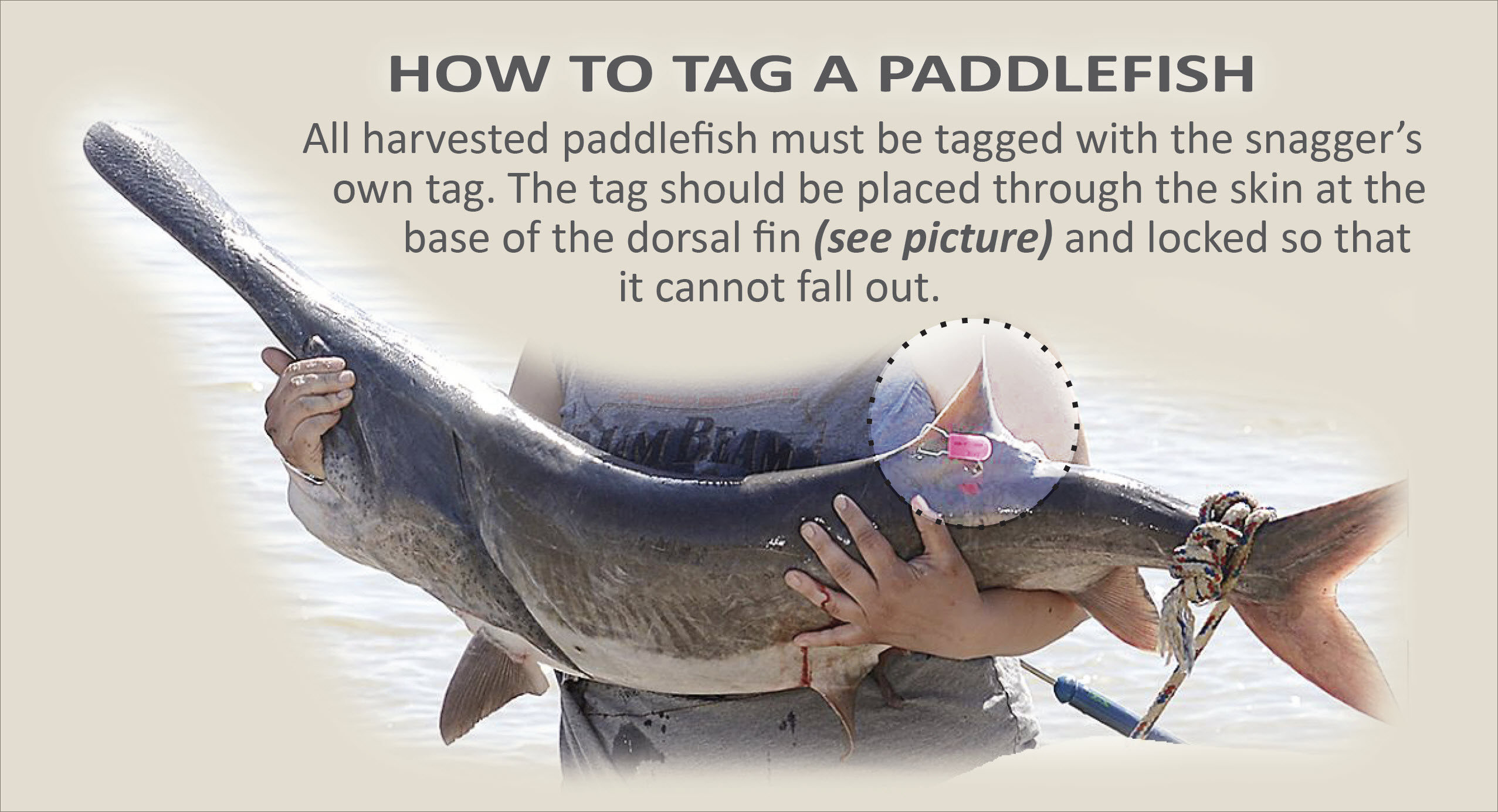
Aquatic Nuisance Species Rules and Q/A
Aquatic nuisance species are animals, plants and even diseases that are not native to North Dakota, can cause some impact, and have the likelihood to become established if introduced. They can negatively impact fishing, displace native plants and animals, and cause serious economic and ecological damage. North Dakota has adopted rules designed to minimize the transport of ANS:
- All water must be drained from boats and other equipment, including bilges, livewells and motors before leaving a water body or entering the state. This regulation means that harvested fish, legal live baitfish and other live aquatic baits may not be transported in a livewell containing water after leaving a water body. Transportation of fish in or on ice is allowed. Potable (drinking) water and a boat's sewage water are excluded from this regulation.
- All drain plugs that hold back water must be removed, and all draining devices must be open on all watercraft and recreational bilges and confined spaces, during any out-of-water transport of same.
- All aquatic vegetation must be removed from boats, personal watercraft, trailers and associated equipment, such as fishing poles/lures, before leaving a body of water or prior to entering the state. That means "vegetation free" when transporting watercraft and equipment, including bait buckets, away from a boat ramp, landing area or shoreline.
- Live aquatic bait or aquatic vegetation may not be transported into North Dakota. It is in North Dakota's best interest that anglers, boaters and hunters understand and comply with these important regulations. Except for waters containing Class 1: Prohibited Aquatic Nuisance Species (see page 8), water used for in-state transportation of legal live bait is allowed but only in bait buckets (containers) no larger than five gallons.
The following questions and answers are intended to provide additional insight into ANS matters.
Where do I find out more information about ANS in North Dakota, especially which water bodies are infested and what species are considered ANS?
Up-to-date information about ANS can be found here.
Can the spread of ANS be stopped?
If precautions are taken and everyone follows the regulations, the spread can be controlled.
What happens if I catch an ANS fish species?
Class III ANS, such as common carp, silver carp or the newly discovered bighead carp, can be kept for consumption if legally harvested. However, the Department does not recommend releasing any Class III ANS back into a waterbody. If kept, a Class III ANS should be killed and the carcass disposed of properly. All other ANS are illegal to possess and should be left where found. If you find something you believe to be an ANS, report it to the Department through the online reporting form on the Department's website, or by emailing or calling the Department.
Do I have to run my motor dry before I leave a lake?
No. As you exit a lake, lower the motor to let gravity drain the lower unit, then raise to transport. The intake screen should also be inspected and free of aquatic vegetation.
Can I drain water from my boat anywhere?
No, you must drain the water (pull all plugs, etc.) back into the water from which it originated. This must be done at the access site before you leave.
What if I observe boats, trailers, jet skis, etc., that have weeds hanging from them away from a lake?
The best thing you can do is spread the word on the risk of ANS. If the boat owner/operator is present and willing, ask that they clean the boat and trailer. If the owner/operator is not cooperative, call the RAP line at 701-328-9921.
Do I need to dispose of the weeds in a trash container or can they be left on the ground/parking lot?
Dispose of weeds back into the water from which they originated, to keep parking lots and access areas clean.
Can I cross the state line to purchase live aquatic bait and transport it back into North Dakota?
No. Live aquatic bait, including fathead minnows and leeches, may not be imported into North Dakota.
What else can I do to help prevent the spread of ANS?
The single most important step all anglers and boaters can take to prevent the spread of ANS is to be in full compliance of ANS rules and regulations. In addition, boaters are encouraged to thoroughly wash their watercraft down after each outing with hot water (120-140 degrees Fahrenheit at the point of contact) and pressure washing equipment. Between outings, boaters are also encouraged to thoroughly dry their watercraft, fishing gear or other equipment.
Is there anything new for 2020-2022?
Legislation was approved in 2019 which provided additional staff and funding to enhance and increase ANS education, inspection and monitoring programs conducted by the Department. More North Dakota waters will be monitored annually for ANS. Education and inspection efforts will also increase for the multiple, high-risk pathways of ANS spread. Lastly, there will be more enforcement to enhance compliance with all ANS rules/ regulations. Funding will come from small surcharges on fishing licenses, nonresident waterfowl licenses and new fees on motorized watercraft. Also, zebra mussels were detected in Lake Ashtabula and the Sheyenne River between Lake Ashtabula and the Red River in 2019. Bighead carp were also found in the James River in 2019, which was the first time this fish was documented in the state. Although North Dakota is fortunate to have few species in only a few locations, keep up to date on ANS locations in the state by subscribing to the Department's Facebook page and/or checking the Department's website periodically.
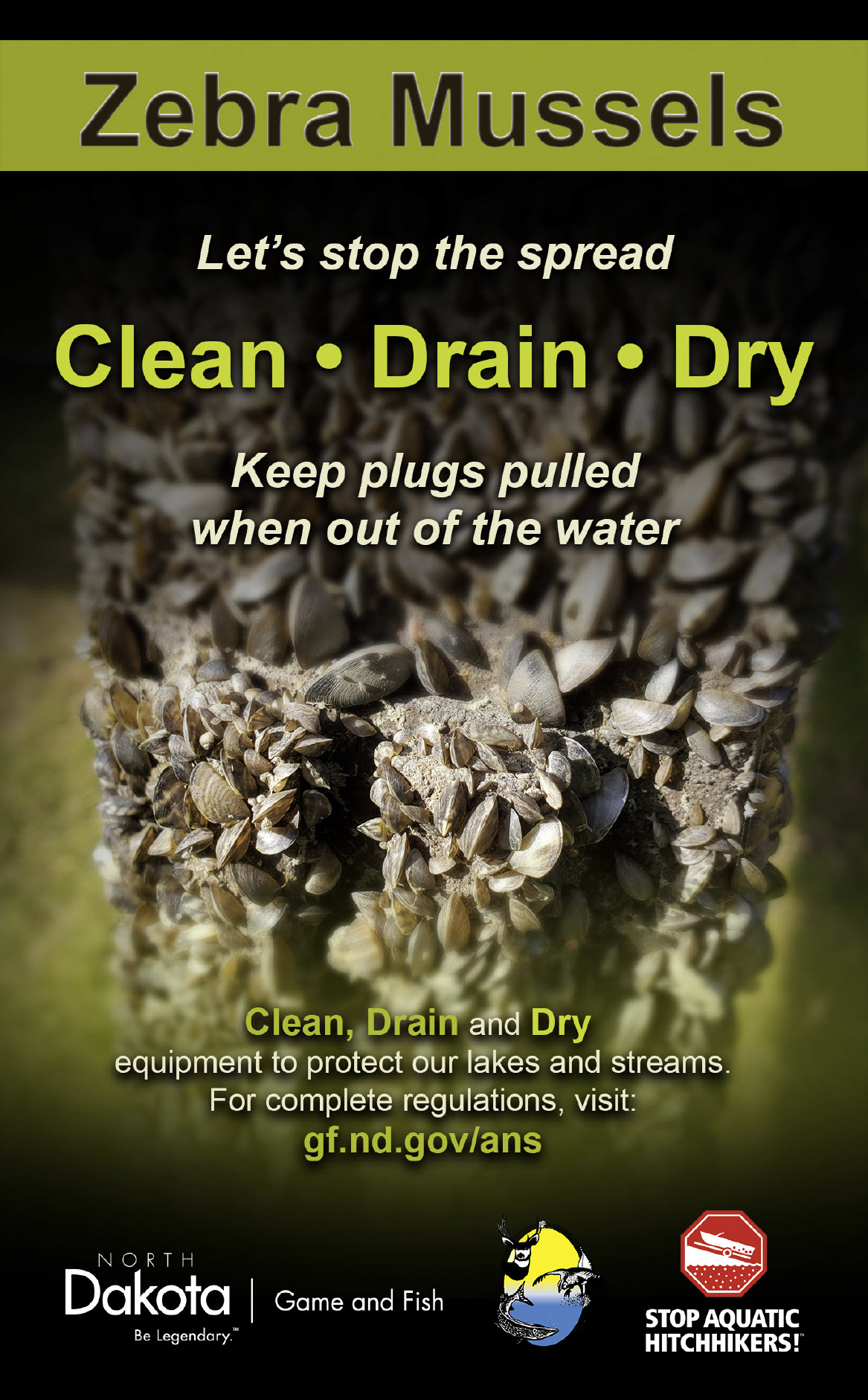
Informational
Fish Length-Weight Table
The following table is intended to assist an angler with a weight estimate based on the fish's length. The table shows the average weights of select fish statewide. The true weight of an individual fish may vary due to the sex of the fish, time of year (e.g. spawning) when it is caught, health of the fish and the water body from which it is caught.
| Species | Bluegill | Crappie | Yellow Perch | White Bass | Smallmouth Bass | Largemouth Bass | Walleye | Channel Catfish | Northern Pike |
|---|---|---|---|---|---|---|---|---|---|
| Inches | Estimated Pounds | ||||||||
| 6 | 0.2 | 0.1 | 0.1 | 0.1 | 0.1 | 0.1 | |||
| 7 | 0.3 | 0.2 | 0.2 | 0.2 | 0.2 | 0.2 | |||
| 8 | 0.5 | 0.3 | 0.3 | 0.3 | 0.3 | 0.3 | 0.2 | ||
| 9 | 0.7 | 0.4 | 0.4 | 0.4 | 0.4 | 0.4 | 0.3 | ||
| 10 | 1 | 0.5 | 0.5 | 0.5 | 0.5 | 0.6 | 0.3 | 0.3 | |
| 11 | 1.3 | 0.7 | 0.7 | 0.7 | 0.7 | 0.8 | 0.4 | 0.4 | |
| 12 | 1.7 | 1 | 1 | 0.9 | 0.9 | 1 | 0.6 | 0.5 | 0.4 |
| 13 | 1.2 | 1.3 | 1.2 | 1.2 | 1.3 | 0.7 | 0.6 | 0.5 | |
| 14 | 1.5 | 1.6 | 1.5 | 1.5 | 1.6 | 0.9 | 0.8 | 0.6 | |
| 15 | 1.9 | 1.9 | 1.9 | 1.8 | 2 | 1.1 | 0.9 | 0.7 | |
| 16 | 2.3 | 2.2 | 2.3 | 2.2 | 2.4 | 1.4 | 1.2 | 0.9 | |
| 17 | 2.7 | 2.6 | 2.9 | 1.7 | 1.4 | 1.1 | |||
| 18 | 3.3 | 3.2 | 3.4 | 2 | 1.7 | 1.3 | |||
| 19 | 3.8 | 3.7 | 4.1 | 2.4 | 2.3 | 1.5 | |||
| 20 | 4.3 | 4.4 | 4.7 | 2.9 | 2.9 | 1.8 | |||
| 21 | 5.1 | 5.5 | 3.3 | 3 | 2.1 | ||||
| 22 | 5.9 | 6.4 | 3.9 | 3.4 | 2.4 | ||||
| 23 | 6.8 | 7.3 | 4.5 | 4 | 2.7 | ||||
| 24 | 7.7 | 8.3 | 5.1 | 4.8 | 3.2 | ||||
| 25 | 5.8 | 5.8 | 3.7 | ||||||
| 26 | 6.6 | 6.5 | 4.1 | ||||||
| 27 | 7.4 | 8.7 | 4.6 | ||||||
| 28 | 8.3 | 9.7 | 5.1 | ||||||
| 29 | 9.3 | 10.1 | 5.7 | ||||||
| 30 | 10.4 | 11.2 | 6.3 | ||||||
| 31 | 12.7 | 11.9 | 7 | ||||||
| 32 | 13.5 | 7.7 | |||||||
| 34 | 17 | 9.2 | |||||||
| 36 | 21 | 11 | |||||||
| 38 | 26 | 13 | |||||||
| 40 | 15.2 | ||||||||
| 42 | 17.6 | ||||||||
| 44 | 20.3 | ||||||||
| 46 | 23.2 | ||||||||
| 48 | 26.5 | ||||||||
| 50 | 30 | ||||||||
Whopper/Catch and Release Requirements
Whopper Club
Only species listed and meeting minimum weight requirements will qualify for a recognition sticker and certificate. Only one application may be made for each species in a lifetime.
An application card must be filled out, giving weight and length of fish, date and where caught, signature of applicant, and signature of person weighing the fish. Applications must be submitted within 90 days of when the fish was caught. Application cards can be found on the Department's website and select bait shops around the state.
All fish entered must have been harvested by legal methods as described in the North Dakota fishing guide and come from North Dakota waters open to public fishing. Entries must be weighed on a scale used in trade.
Catch and Release Club
Entries must meet minimum length requirements and be released unharmed back to the water. Another angler must witness and verify the measurement and release.
Qualifying anglers will receive a recognition sticker and certificate. A maximum of five entries per year per species will be recognized. Applications must be submitted within 90 days of when the fish was caught.

Whopper and Catch and Release Minimums
| Species | Minimum Whopper Club | Minimum Catch and Release Club |
|---|---|---|
| Game Fish | ||
| Northern Pike | 20lbs. | 36 inches |
| Walleye* | 8lbs. | 25 inches |
| Saugeye | 8lbs. | 25 inches |
| Sauger | 4lbs. | 20 inches |
| Yellow Perch | 1lb. 12 oz. | 13 inches |
| Bluegill | 1lb. 4 oz. | 10 inches |
| Crappie | 1lb. 8 oz. | 13 inches |
| White Bass | 3lbs. | 16 inches |
| Largemouth Bass | 5lbs. | 18 inches |
| Smallmouth Bass | 3lbs. | 18 inches |
| Tiger Muskie | 30lbs. | 40 inches |
| Muskellunge (Pure) | 30lbs. | 40 inches |
| Channel Catfish | 12lbs. | 30 inches |
| Burbot (Ling) | 8lbs. | 28 inches |
| Rainbow Trout | 5lbs. | 21 inches |
| Brown Trout | 5lbs. | 21 inches |
| Cutthroat Trout | 5lbs. | 21 inches |
| Chinook Salmon | 12lbs. | |
| Paddlefish | 70lbs. | |
| *This includes zander in Spiritwood/Alkali Lakes. | ||
| NONGAME FISH | ||
| Whitefish | 4lbs. | |
| Cisco | 1lb. 12 oz. | |
| Bullhead | 2lbs. | |
| Drum | 6lbs. | |
| Buffalo | 20lbs. | |
| Carp | 15lbs. | |
| Goldeye | 2lbs. | |
North Dakota State Record Fish Requirements
- All recognized fish must be harvested by a legal manner of taking for recreational fishing, originate from North Dakota waters that are open for public fishing, and must have been caught by the angler seeking "state record" recognition.
- All new state record fish must be weighed on a scale used commercially and certified by the North Dakota Public Service Commission, or an equivalent authoritative agency in other states or Canadian provinces. All weights must be rounded to the nearest ounce.
- Angler must thoroughly complete and submit to the Department a "Whopper" card application or a hand-written or typed note with all similar information. The angler's signature must be included in the submitted documentation.
- At least one witness must verify the weight and provide their signature.
- The actual fish (not pictures) must be visually verified by an employee of the North Dakota Game and Fish Department within 30 days of the catch.
- A recognizable photo of the fish must be furnished to the Department.
- The Department may –
- Further investigate whether a fish was legally taken including interviews with the applicant and/or witnesses,
- Use some/all of the fish for genetic analysis and/or a thorough physical examination of the fish, and
- Reject any applications which are questionable.
- After a waiting period of at least four weeks and when all conditions above are met, the Department will recognize a fish as a state record.
North Dakota Record Fish
| Species | Weight | Where | When |
|---|---|---|---|
| Northern Pike | 37 lbs.8 oz. | Lake Sakakawea | 1968 |
| Walleye | 15 lbs.13 oz. | Missouri River | 2018 |
| Saugeye | 12 lbs.0 oz. | Yellowstone River | 2013 |
| Sauger | 8 lbs.12 oz. | Lake Sakakawea | 1971 |
| Yellow Perch | 2 lbs.15 oz. | Devils Lake | 1982 |
| Bluegill | 2 lbs.12 oz. | Strawberry Lake | 1963 |
| Crappie | 3 lbs.4 oz. | Lake Oahe | 1998 |
| Crappie | 3 lbs.4 oz. | Jamestown Reservoir | 2013 |
| White Bass | 4 lbs.10 oz. | Devils Lake | 2012 |
| Largemouth Bass | 8 lbs.8 oz. | Nelson Lake | 1983 |
| Smallmouth Bass | 6 lbs.13 oz. | Lake Darling | 2007 |
| Tiger Muskie | 40 lbs. | Gravel Lake | 1975 |
| Muskellunge | 46 lbs.8 oz. | New Johns Lake | 2007 |
| Channel Catfish | 42 lbs.1 oz. | Moon Lake | 2009 |
| Burbot (Ling) | 18 lbs.4 oz. | Knife River | 1984 |
| Rainbow Trout | 21 lbs.4 oz. | Garrison Tailrace | 1998 |
| Brown Trout | 31 lbs.11 oz. | Garrison Tailrace | 2005 |
| Cutthroat Trout | 10 lbs.1 oz. | Garrison Tailrace | 2003 |
| Lake Trout | 16 lbs.6 oz. | Garrison Tailrace | 2012 |
| Chinook Salmon | 31 lbs.2 oz. | Garrison Tailrace | 1986 |
| Paddlefish* | 131 lbs.0 oz | Upper Missouri River | 2016 |
| Nongame Fish | |||
| Whitefish | 8 lbs. 11 oz. | Garrison Tailrace | 1984 |
| Cisco | 2 lbs. 9 oz. | Lake Oahe | 2015 |
| Bullhead | 4 lbs. 1 oz. | Devils Lake | 1988 |
| Drum | 26 lbs. 2 oz. | Lake Sakakawea | 1988 |
| Buffalo | 54 lbs. | Heart Butte Tailrace | 2011 |
| Buffalo** | 57 lbs. 8 oz. | Heart Butte Reservoir | 2017 |
| Carp | 31 lbs. | Sheyenne River | 2003 |
| Carp** | 31 lbs. 9 oz. | Etta-Alkaline | 2017 |
| Goldeye | 4 lbs. 3 oz. | Lake Audubon | 2014 |
Method of take is by hook and line fishing unless marked with * which indicates paddlefish snagging or ** which indicates archery (bow)
Reporting Tagged Fish
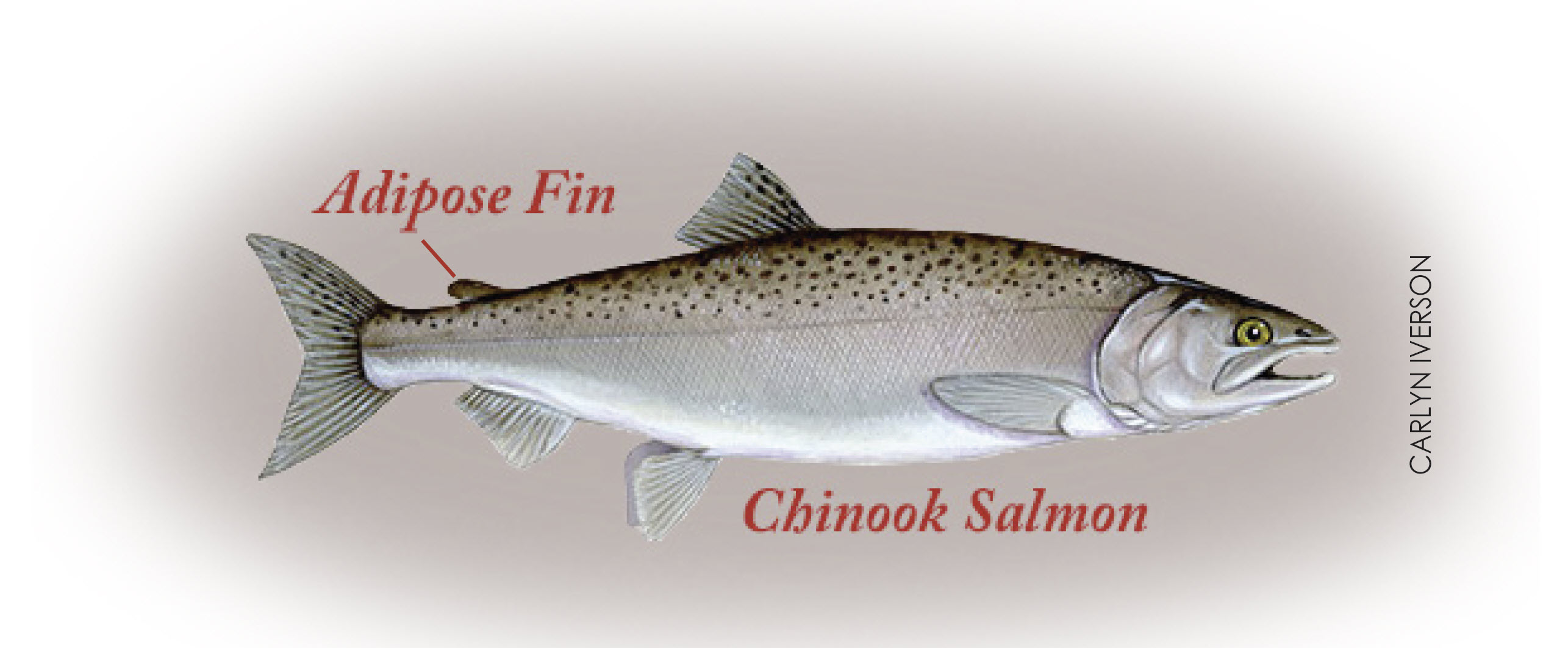
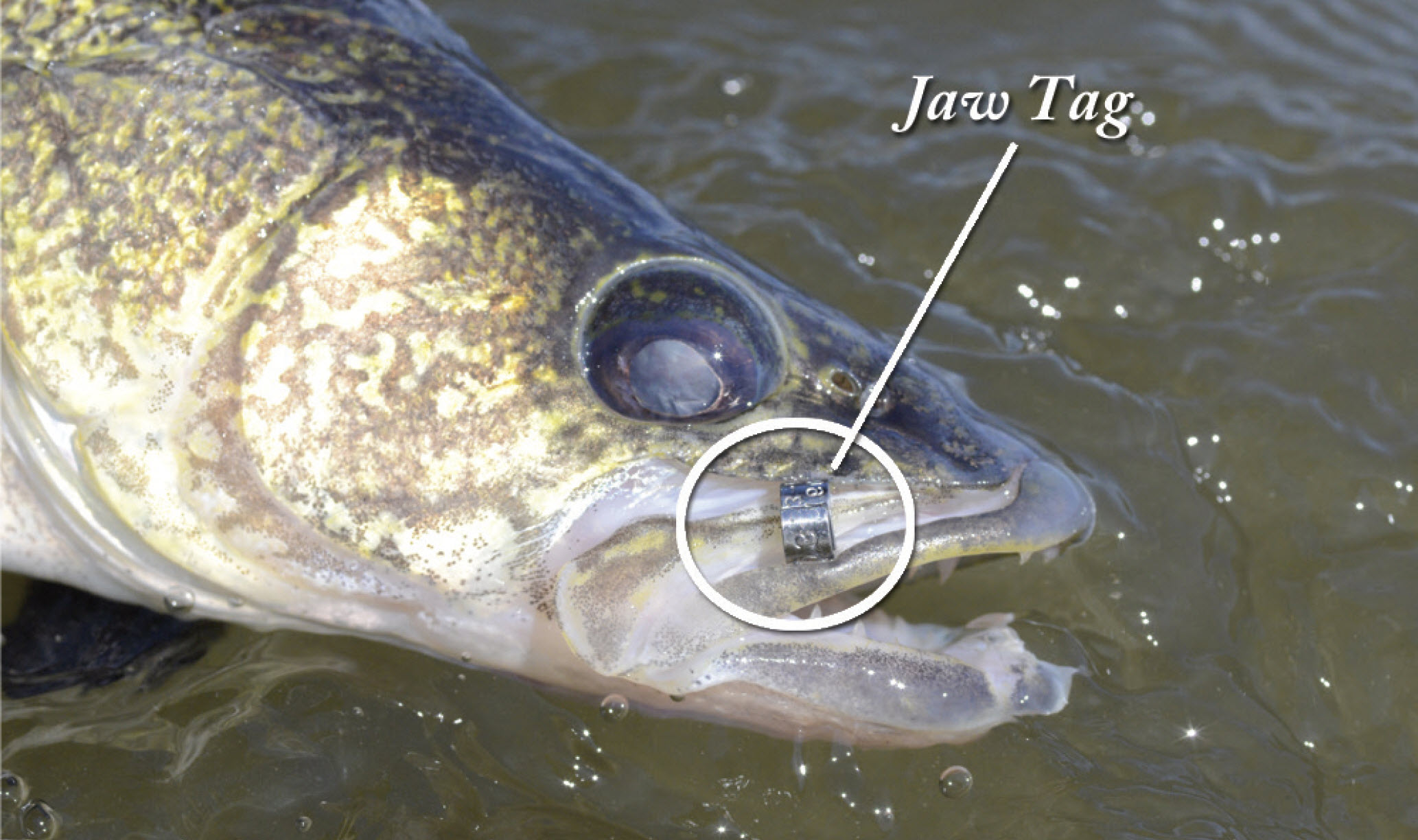
Anglers can help fisheries managers by reporting information from any tagged fish they catch.
Most tagged fish in North Dakota, except salmon, will have either a small metal tag attached near the dorsal fin, or a metal tag on their jaw bone (see below). Tagged salmon have their adipose fin removed and also have a microscopic coded wire tag embedded in their head. If you catch a salmon that's missing its adipose fin, you can drop off the entire head at Game and Fish offices or at bait shops in Riverdale and Pick City.
Please treat tagged fish like any other fish – you are not required to release the fish (except where a harvest regulation requires you to do so). If you release the fish, do not remove the tag, but do record the information from the tag to report it later. Important information to report includes species, length (inches), when and where the fish was caught, and the tag number/color. Anglers who include their name and address will receive a brief history of the fish they caught from the local fisheries biologist.
There are various means to report a tagged fish. Some tags include a phone number that you can call to report a tag. Other options include a tag reporting online, sending in a tag reporting card, or simply calling any Department office to report the information over the phone.
Boating Information
Restrictions
Please check for signs at access points or call the Game and Fish Department. "Idle speed only" is defined as operating a boat at the slowest possible speed necessary to maintain steerage (i.e., trolling – with no wake).
Electric Motors Only: (Note: Boats may be propelled manually or with an electric motor. No combustion motor may be operated on these waters): Casselton Reservoir, Davis Dam, Dickinson Dike, Heinrich-Martin Dam, J. Clark Salyer, Kettle Lake, Larimore Dam, Leland Dam, Lightning Lake, McDowell Dam, Mooreton Pond, Sather Dam, Spring Lake Park Ponds and Strawberry Lake (Turtle Mountains).
Idle Speed Only:
- Arroda Lakes
- Arrowwood Wildlife Refuge
- Lake Audubon (north arm)
- Baukol-Noonan Dam
- Baukol-Noonan East Mine Pond
- Belfield Pond
- Boundary Lake
- Brewer Lake
- Camels Hump Dam
- Carbury Dam
- Clausen Springs Lake
- Coal Mine Lake
- Crown Butte
- Davis WPA
- Dion Lake
- Epping-Springbrook Dam
- Fish Creek Dam
- Fordville Dam
- Gravel Lake
- Harmon Lake
- Harmony Lake
- Heart Butte (Lake Tschida) – designated areas only
- Hooker Lake
- Lake Ilo
- Indian Creek Dam
- Jensen Lake
- Jim Lake Wildlife Refuge
- Kota-Ray Dam
- Kraft Slough
- Long Lake Wildlife Refuge
- McClusky Canal proper
- McGregor Dam
- Mirror Lake
- North Golden Lake
- Pelican Lake
- Raleigh Reservoir
- Sheep Creek Dam
- South Carlson Lake
- Sweet Briar Dam
- and along the Missouri River at the mouths of the Heart River, Lakewood, Marina Bay, Misty Waters and Square Butte Creek
Where signed at Devils Lake, boats used for fishing may not obstruct normal boat traffic underneath bridges.
See page 10 for federal refuge boating closures.
Regulations
Any watercraft propelled by motors must have valid registration. Watercraft that is legally registered in a state other than North Dakota, must be registered in North Dakota if the owner has kept the boat in North Dakota for more than 90 days.
- If your address changes, boat ownership changes, boat is destroyed, abandoned, stolen or recovered – you are required to notify the Department within 15 days.
- The certificate of number is not transferable. Anyone purchasing a boat must register the boat in his/her name.
- The Department can issue a new certificate of number to replace one that is lost. The cost is the same as for a new one.
- No person under 12 years of age may operate a motorboat (includes personal watercraft, jetskis, etc.) propelled by a motor of more than 10 horsepower unless the operator is accompanied by a person 18 years of age or older.
- No person 12 through 15 years of age may operate a motorboat or personal watercraft propelled by a motor of more than 10 horsepower unless the operator is accompanied by a person 18 years of age or older, or the operator has taken and passed a Department approved boating course.
- All boats must have a Coast Guard approved personal flotation device (PFD) for each occupant, and those boats over 16 feet in length must also have a Coast Guard approved PFD. Boat occupants age 10 and under must wear their PFD.
- No person may operate any vessel in a reckless or negligent manner such as: » Endangering the life or property of another. » Use of excessive speed during periods of reduced visibility or while in close proximity to other vessels. » Operating in overloaded condition. » Operating within swimming areas designated by markers or by the presence of swimmers. » Operating near dams and other hazardous waters. » Operating in such a manner as to cause a dangerous or damaging wake. » Operation in such a manner as to molest or annoy a person lawfully engaged in fishing.
- No person may operate a motorboat (includes personal watercraft) within 100 feet of a person fishing from a shoreline, a swimmer, swimming/diving raft, or an occupied, anchored or nonmotorized vessel, or within 250 feet of a reduced speed or slow or no-wake sign at greater than slow or no-wake speed.
- No person may operate any motorboat or vessel while intoxicated or under the influence of alcohol or any narcotic drug, barbiturate or marijuana.
- No person may operate or permit operation of a personal watercraft (jetskis, etc.) without each person on board wearing a Coast Guard approved PFD.
- All boats operating between sunset and sunrise must display legal lights.
- The owner/operator of a vessel is required to file a report in writing whenever an accident results in loss of life or disappearance from a vessel, an injury which requires medical treatment beyond first aid, or property damage in excess of $2,000 or complete loss of the vessel.
- Reports in death and injury cases must be submitted within 48 hours.
- Reports in other cases must be submitted within five days. See a complete list of boating regulations online.
Aquatic Nuisance Species Sticker
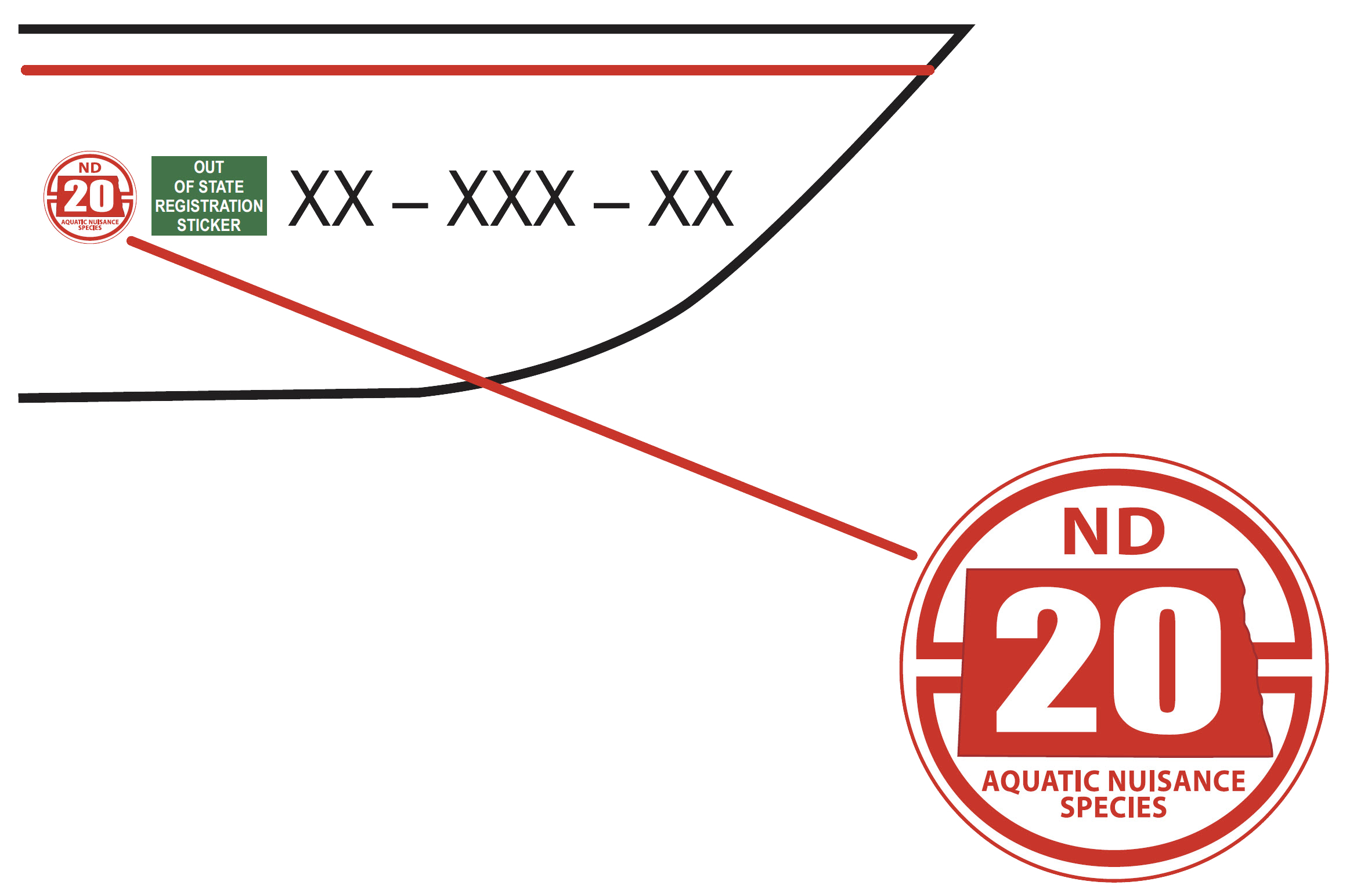
All motorized watercraft not licensed in this state and operated on North Dakota waters must annually obtain a valid, nonrefundable aquatic nuisance species (ANS) sticker. ANS stickers are valid for one calendar year. ANS stickers may only be purchased through the Department's website.
This ANS sticker must be placed on the starboard side of the watercraft within 6 inches of the registration number and displayed within 10 days of purchase.
Each licensed watercraft is listed on the purchase receipt. A copy of the purchase receipt is proof of validation until the sticker is received via postal mail.
Posted by: alonsoalonsoschwanbeckea0252125.blogspot.com
Source: https://gf.nd.gov/fishing/regulations-guide/2020-22

